
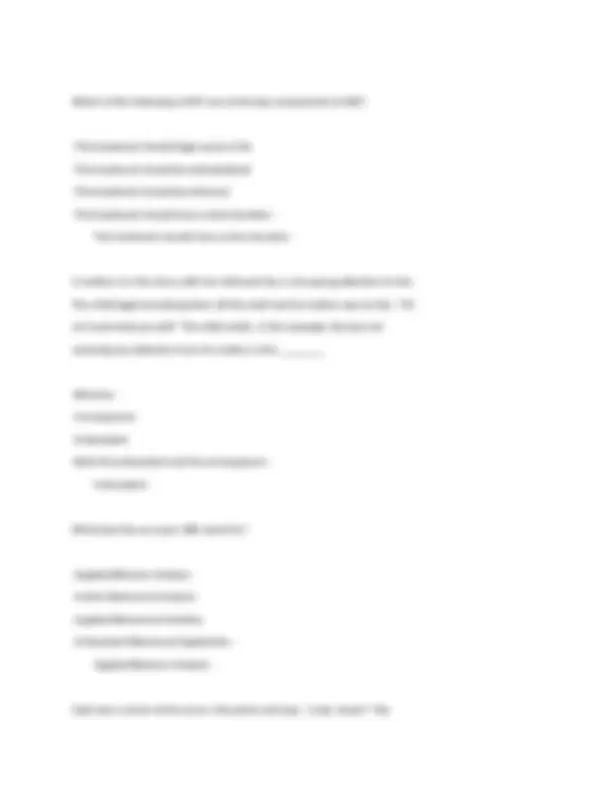
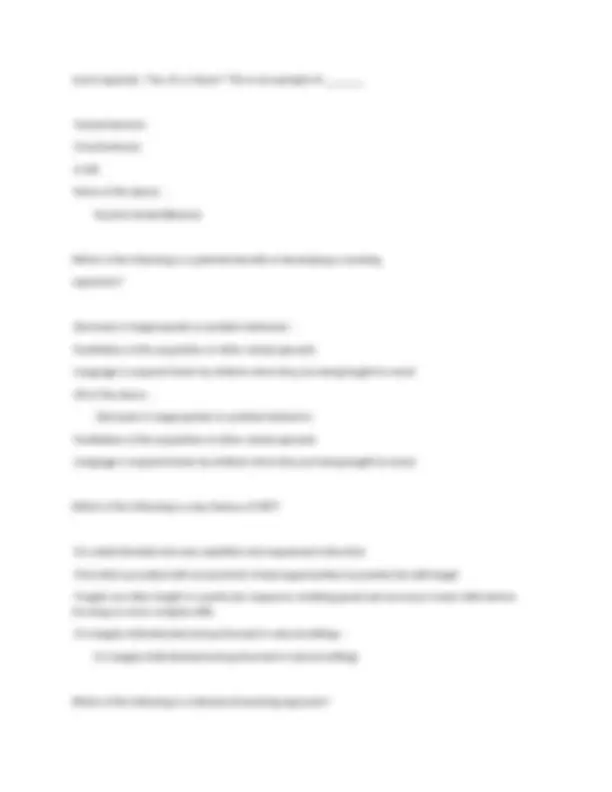
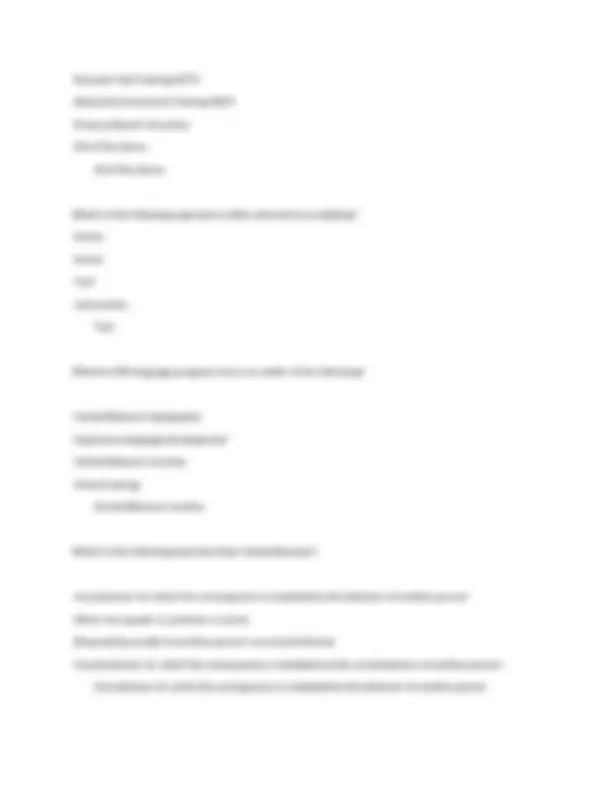
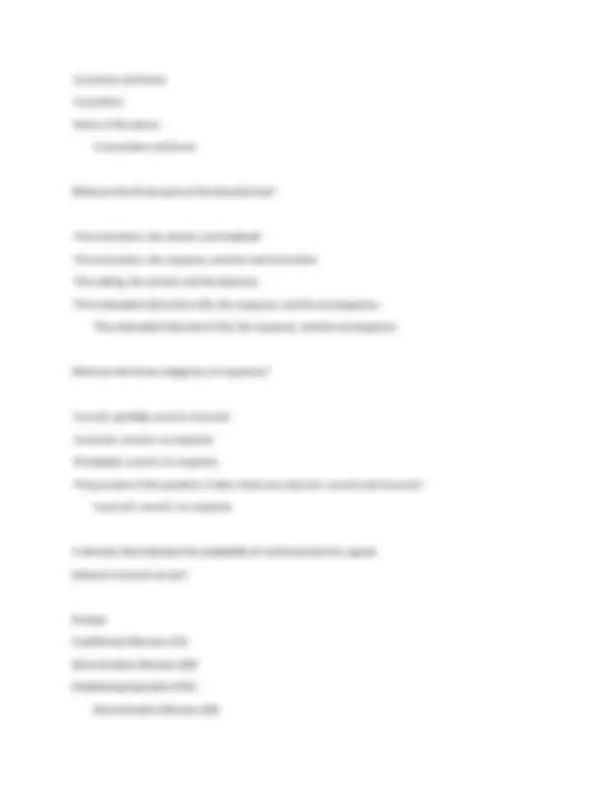
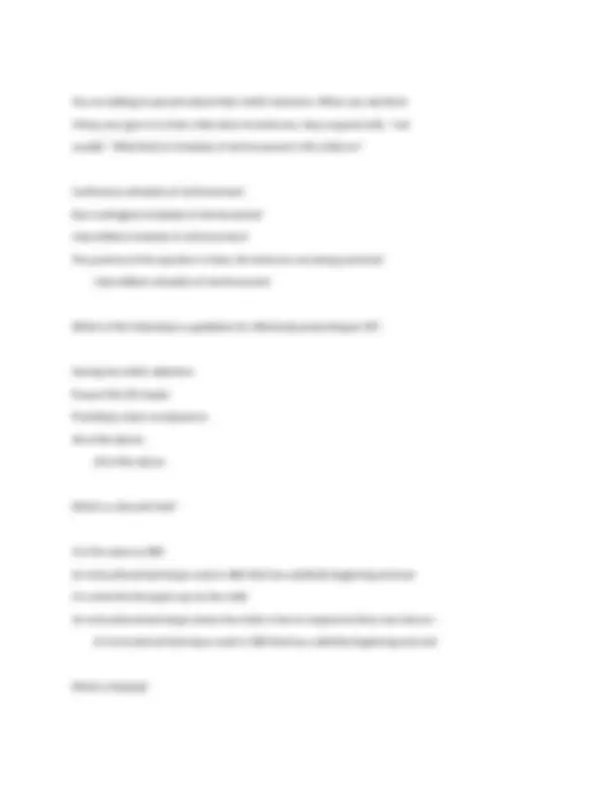

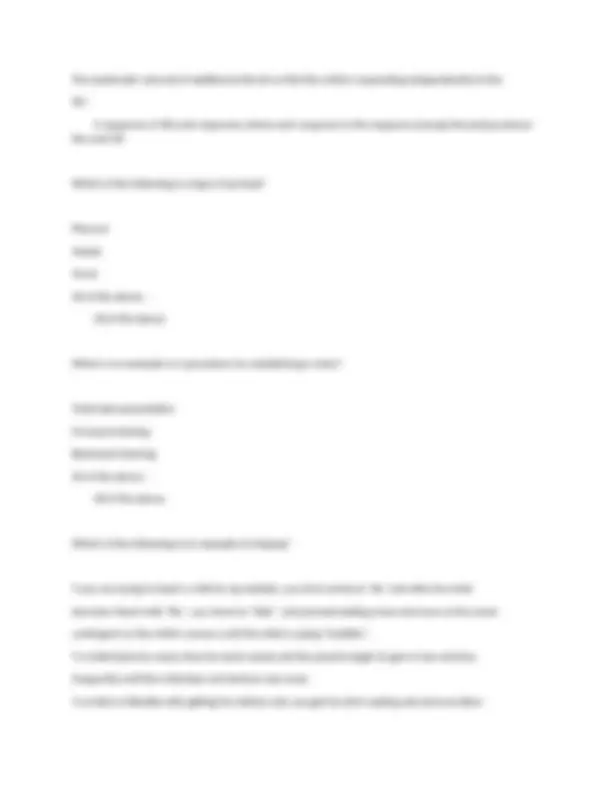
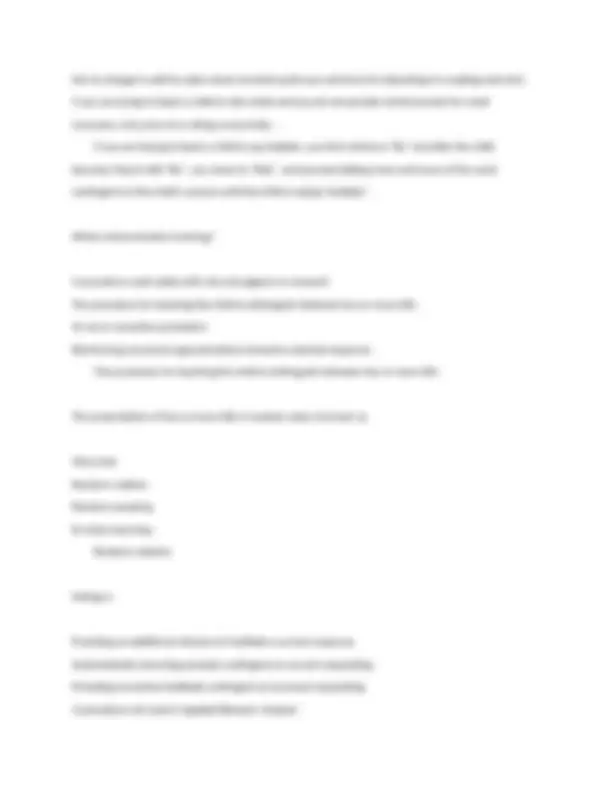
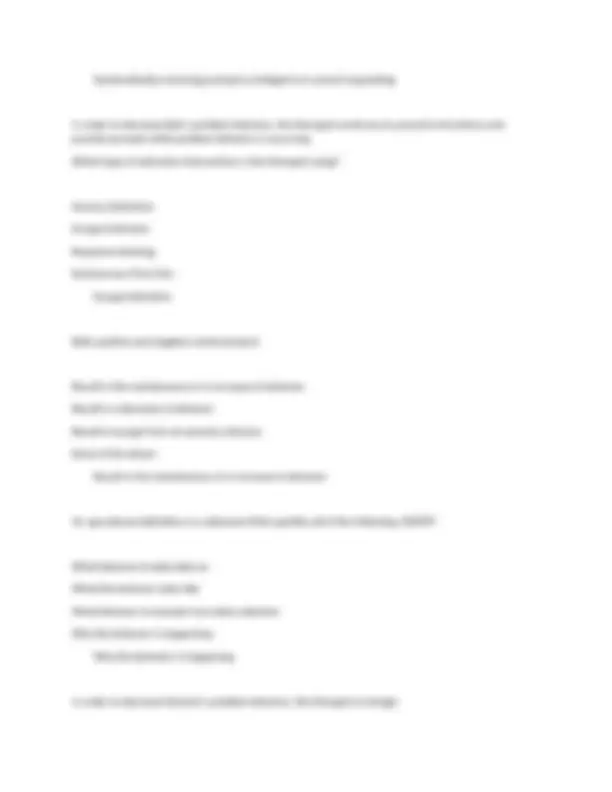
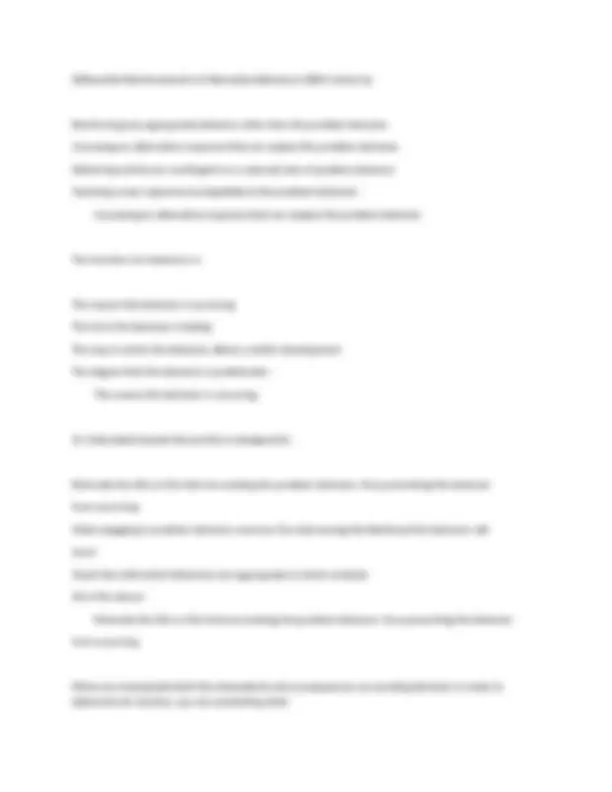
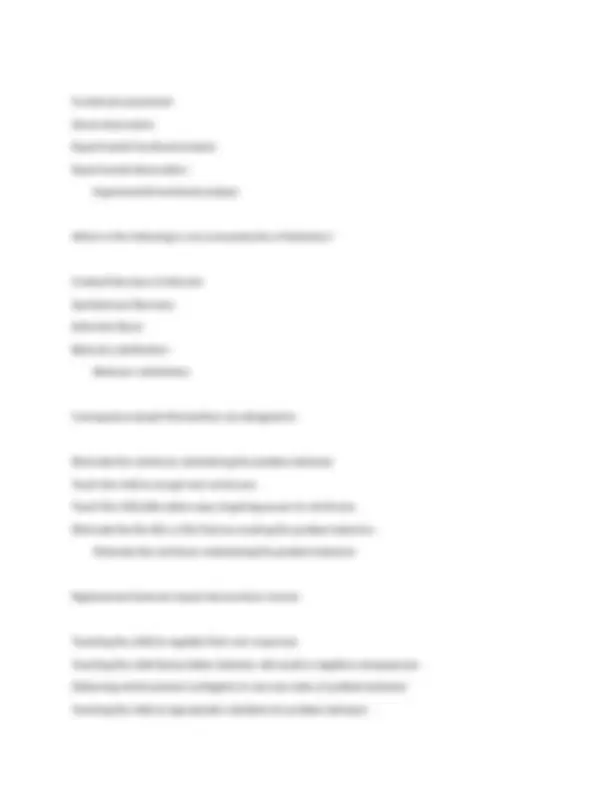
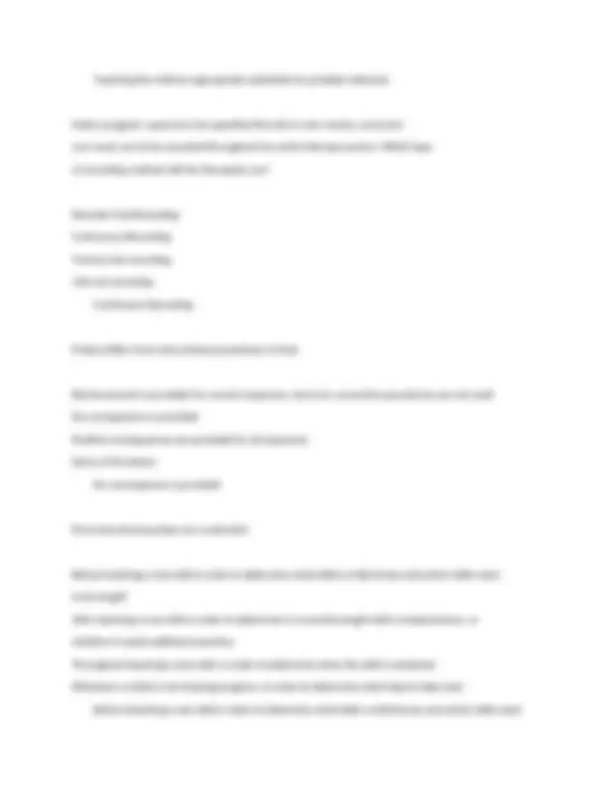
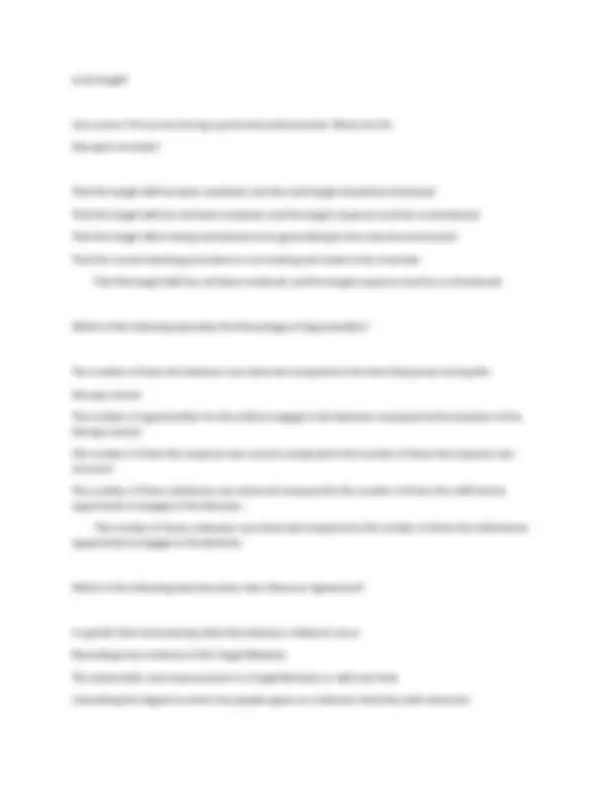
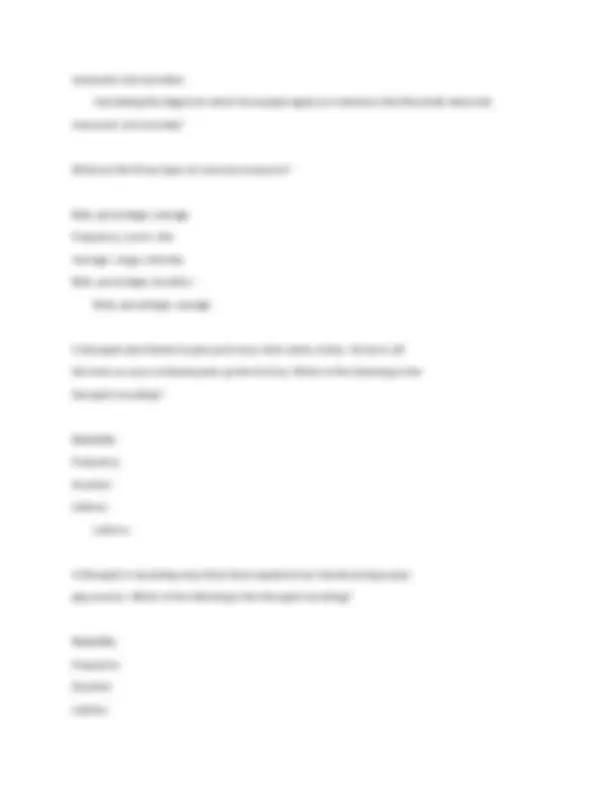
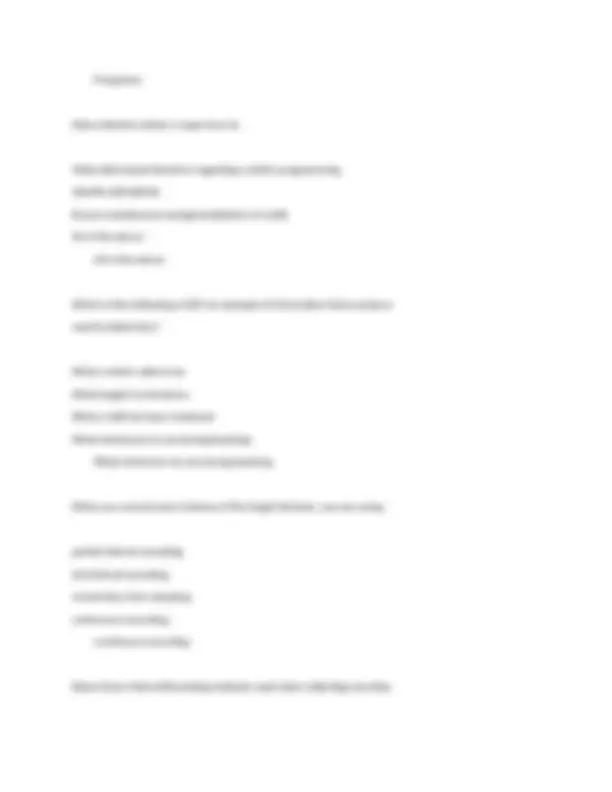
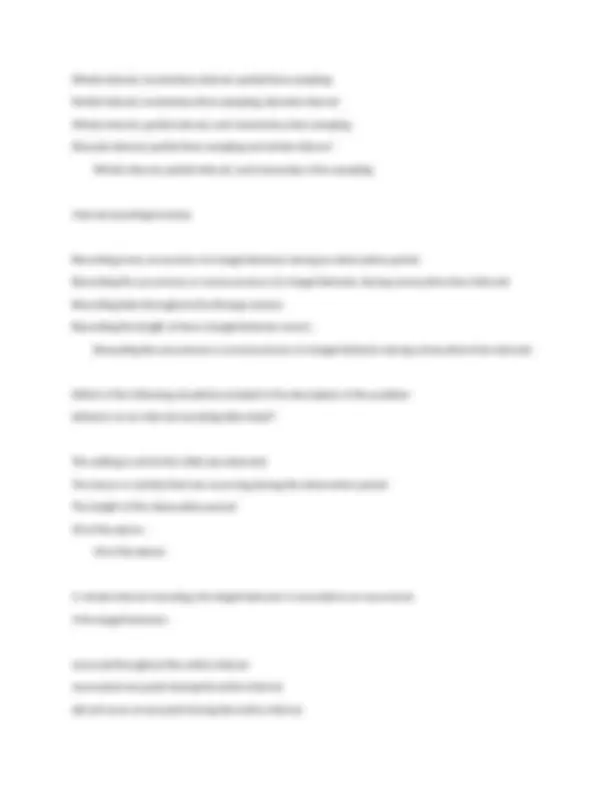
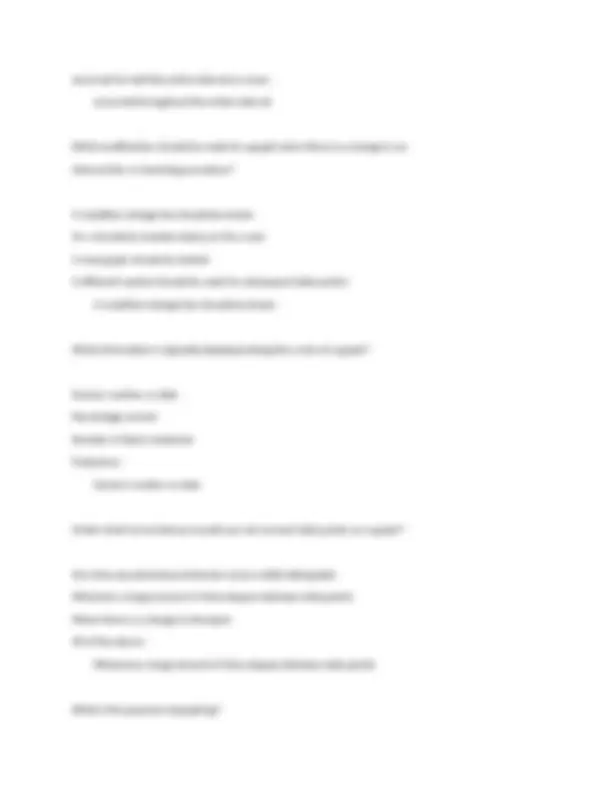
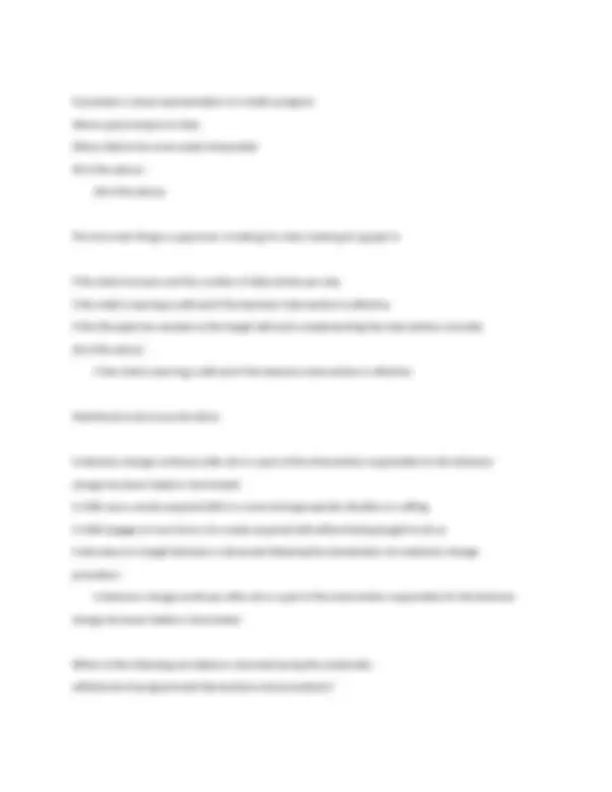
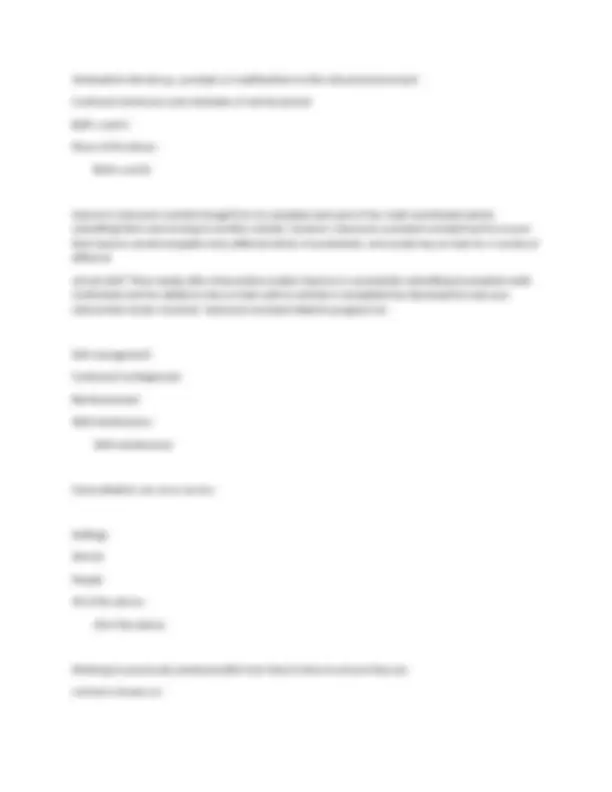
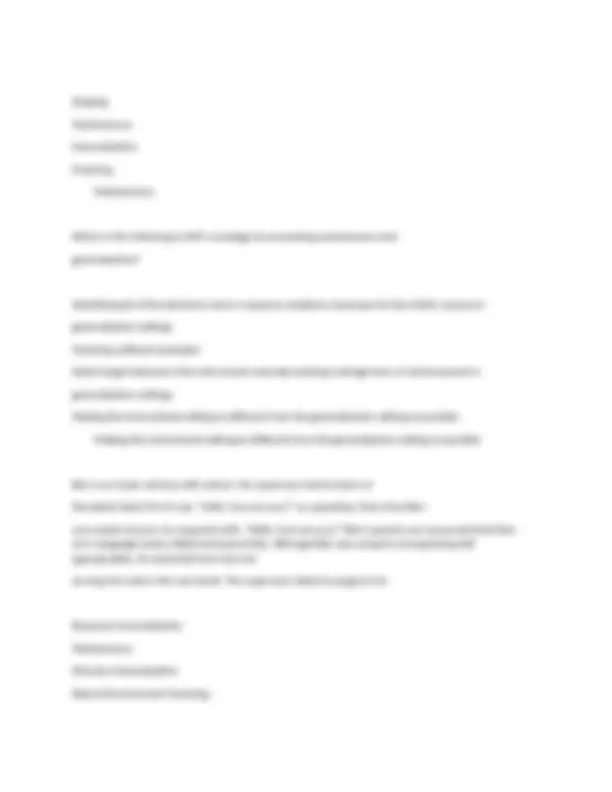
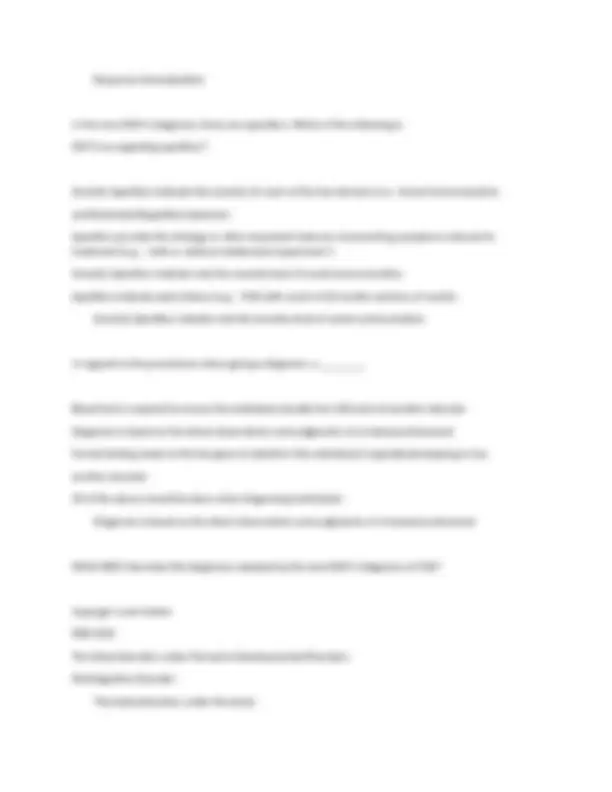
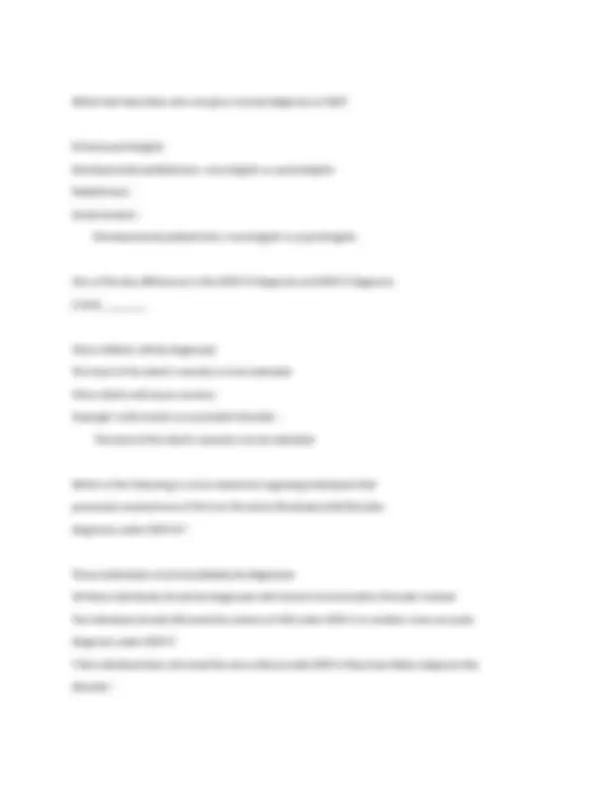
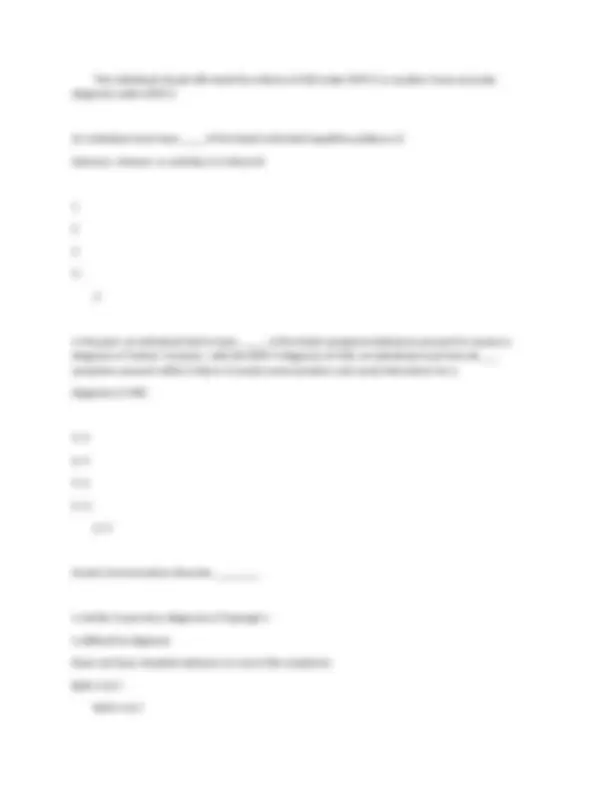
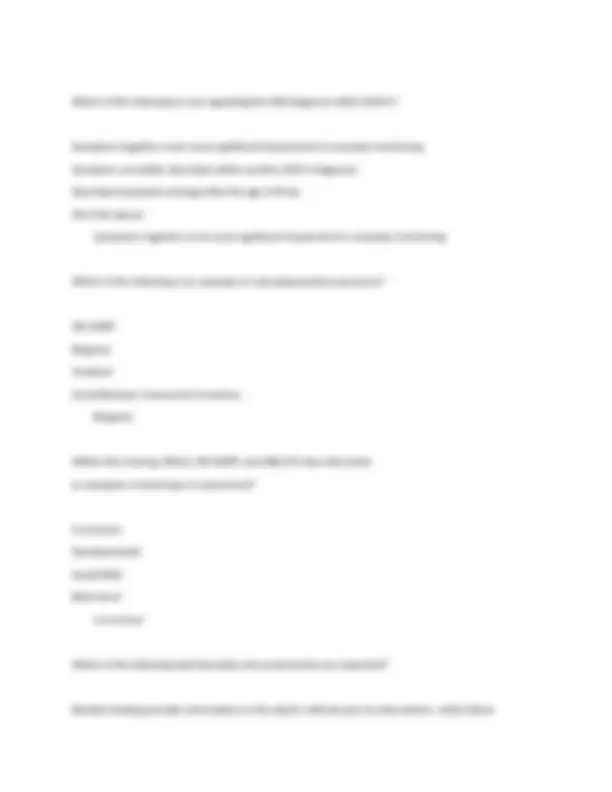
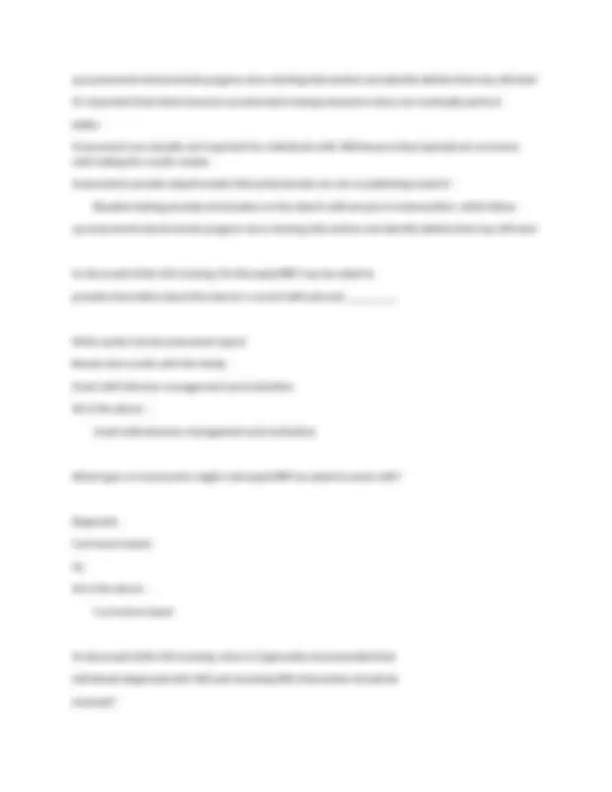
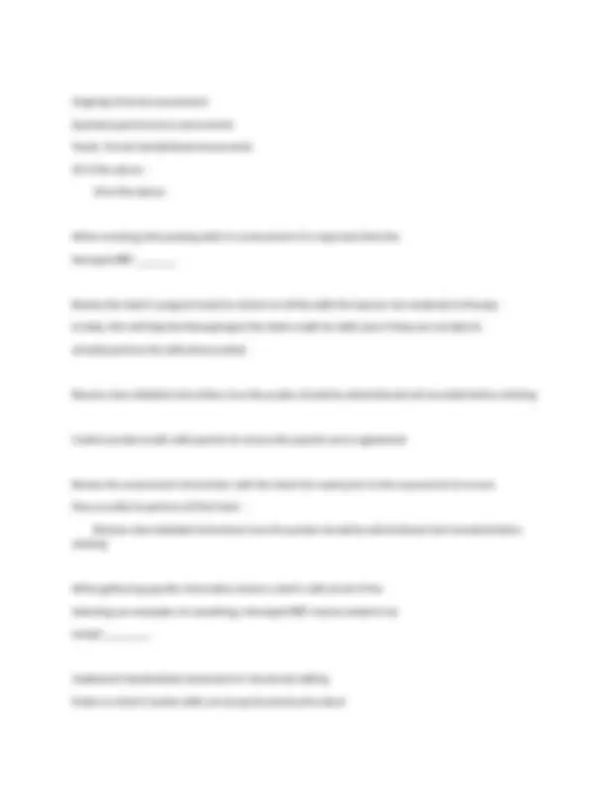
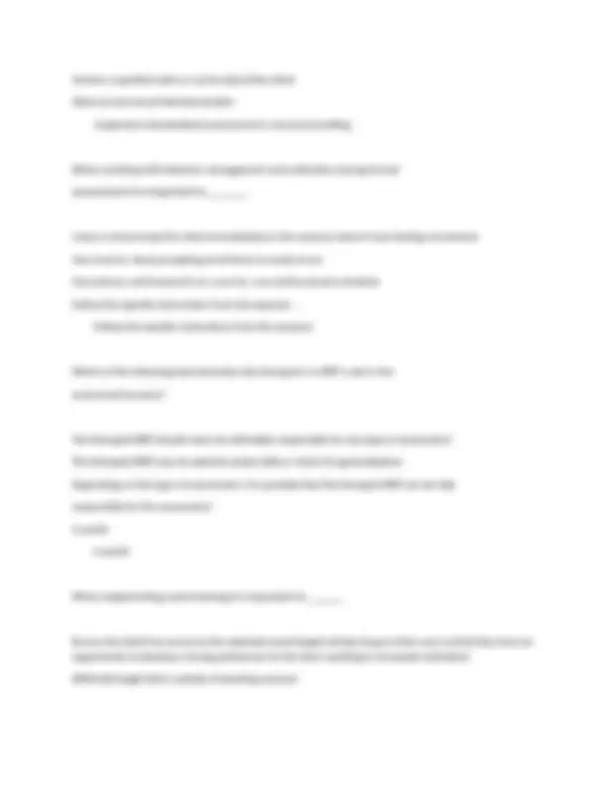
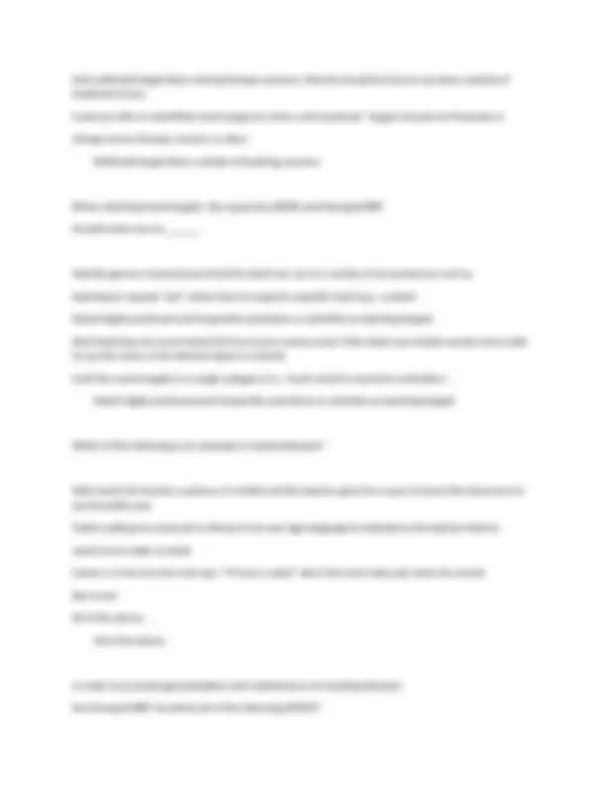
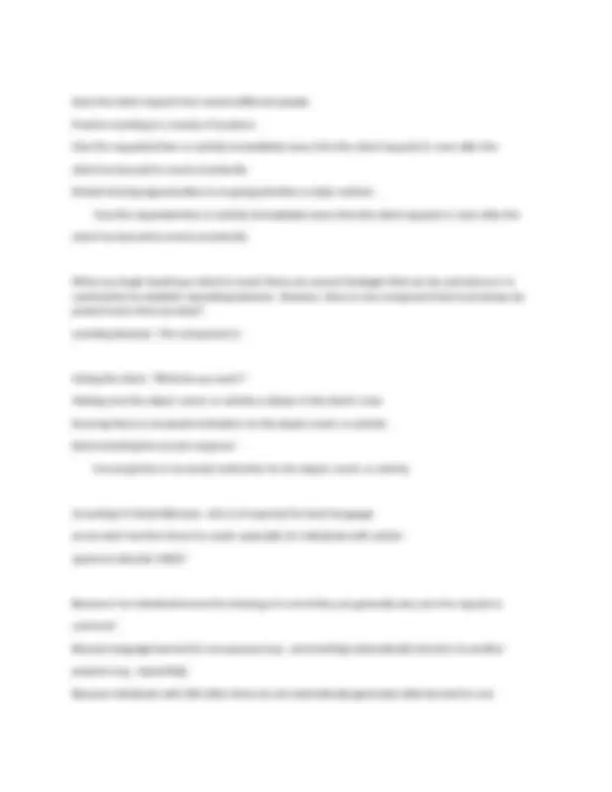
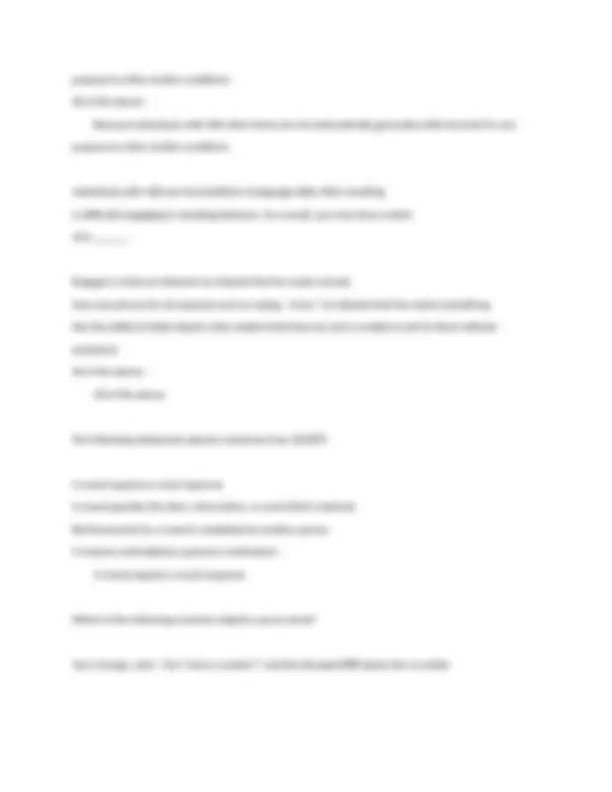
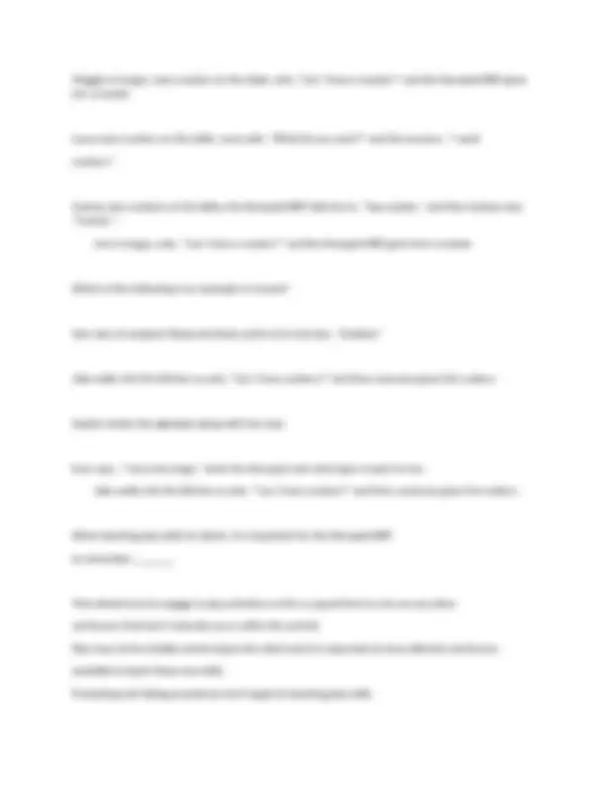
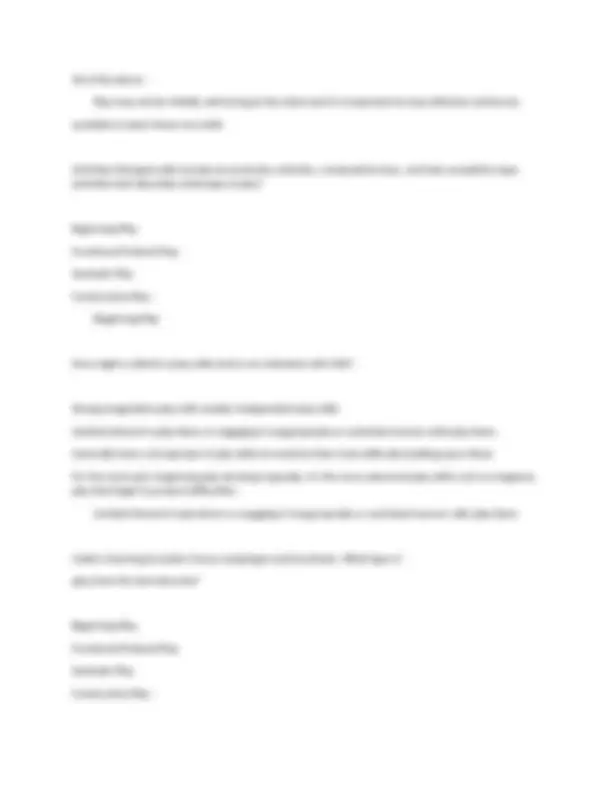
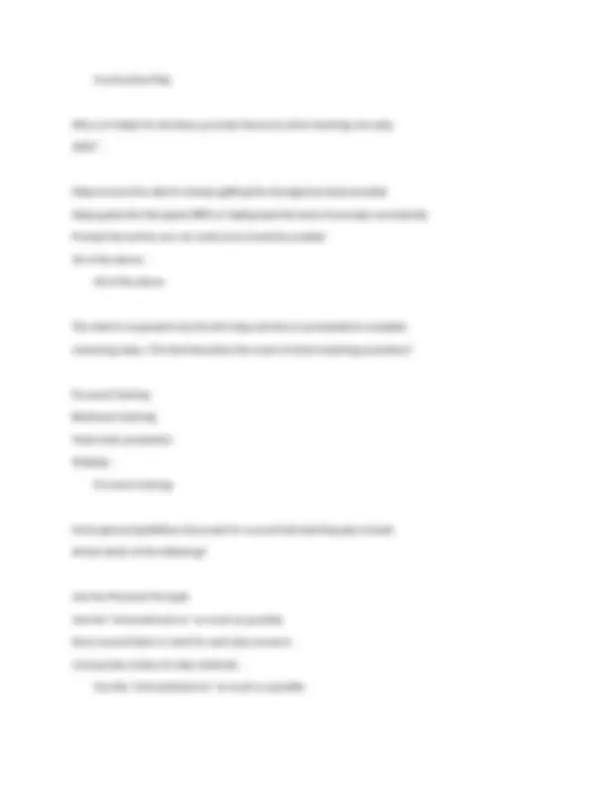
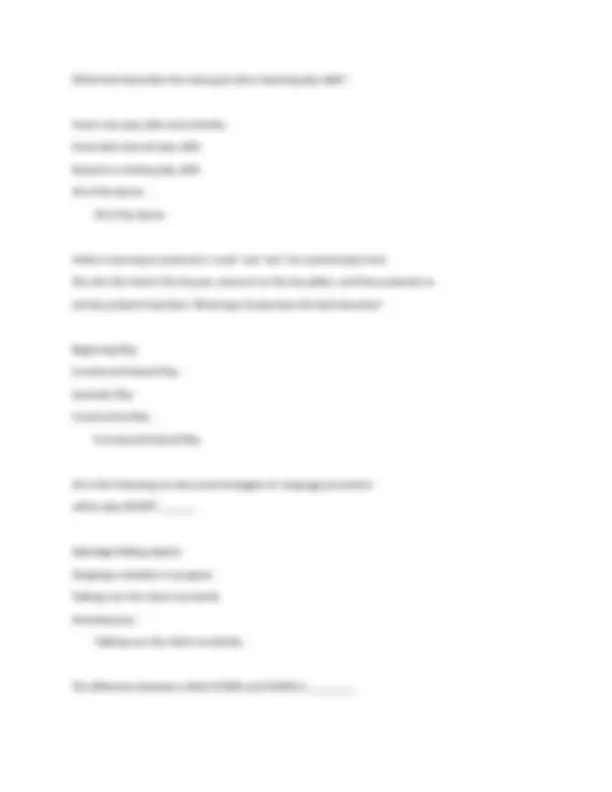

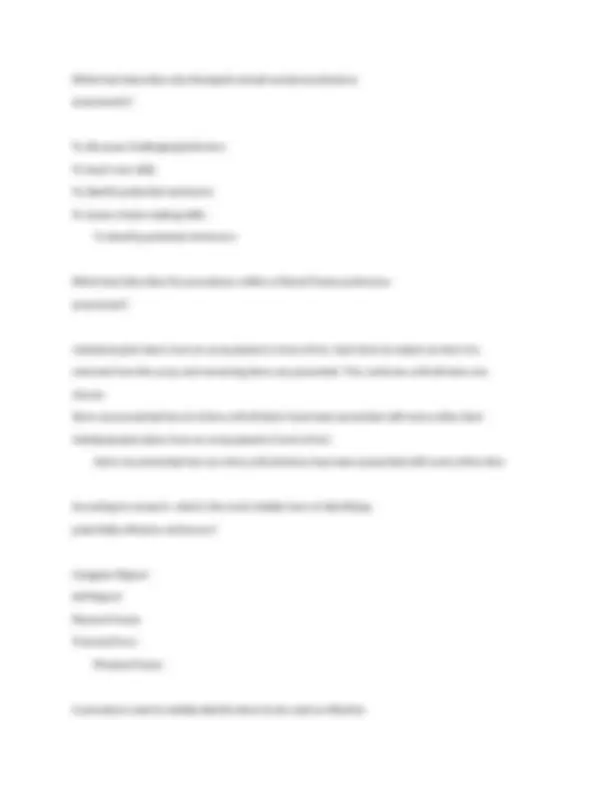
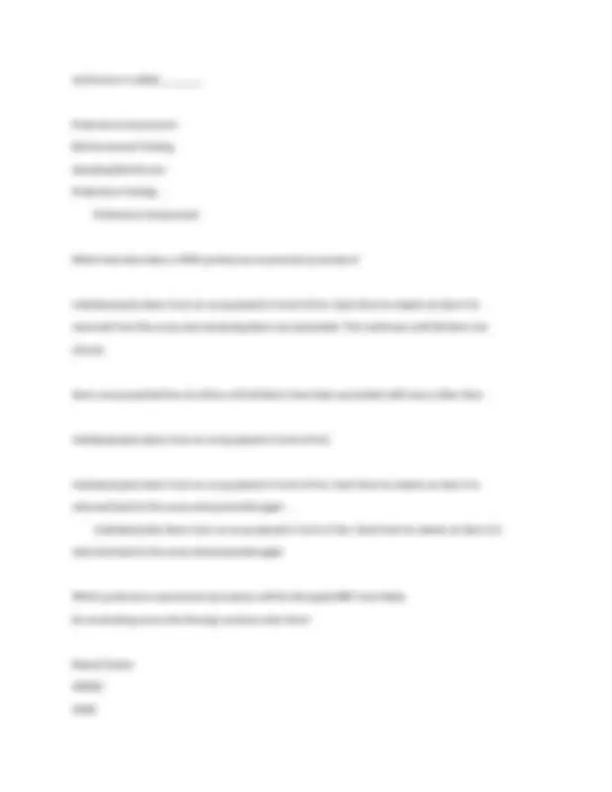

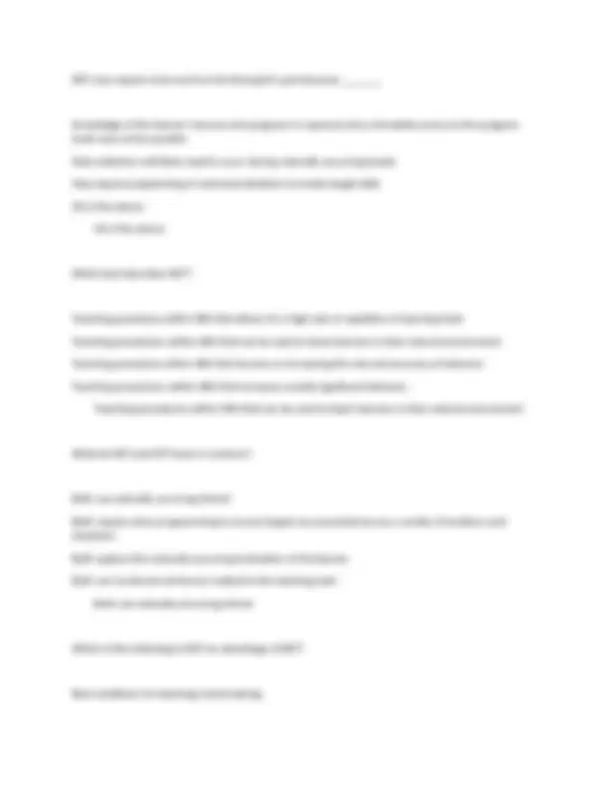
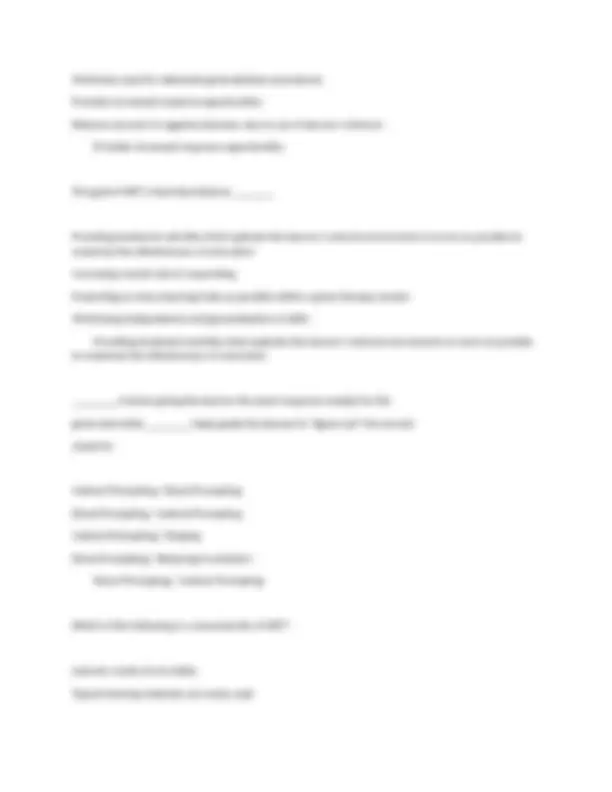
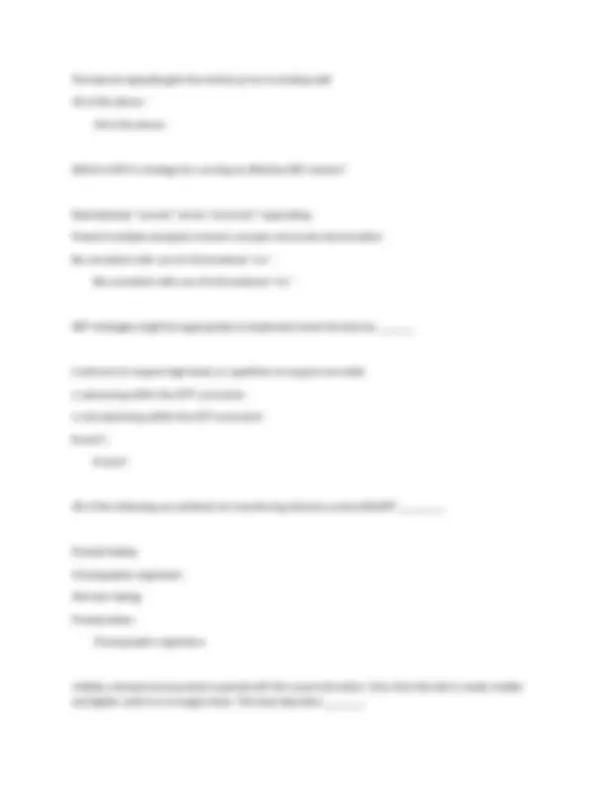
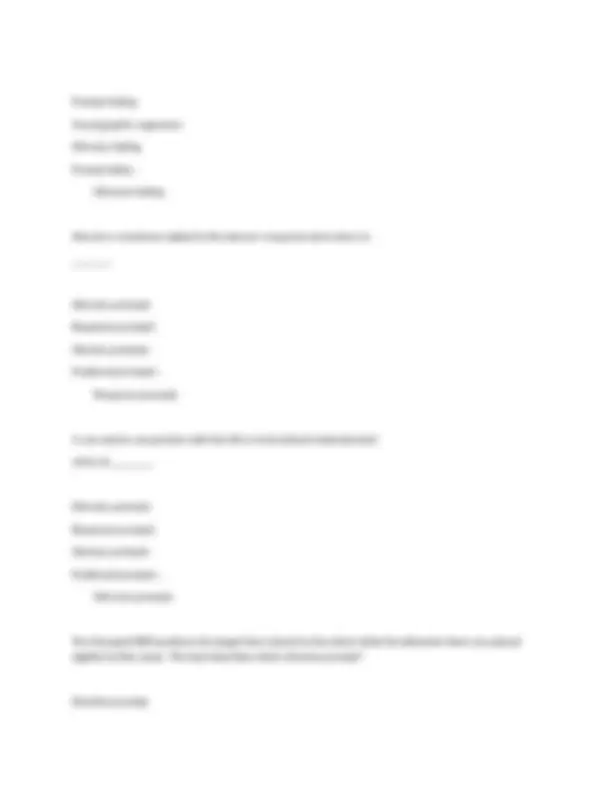
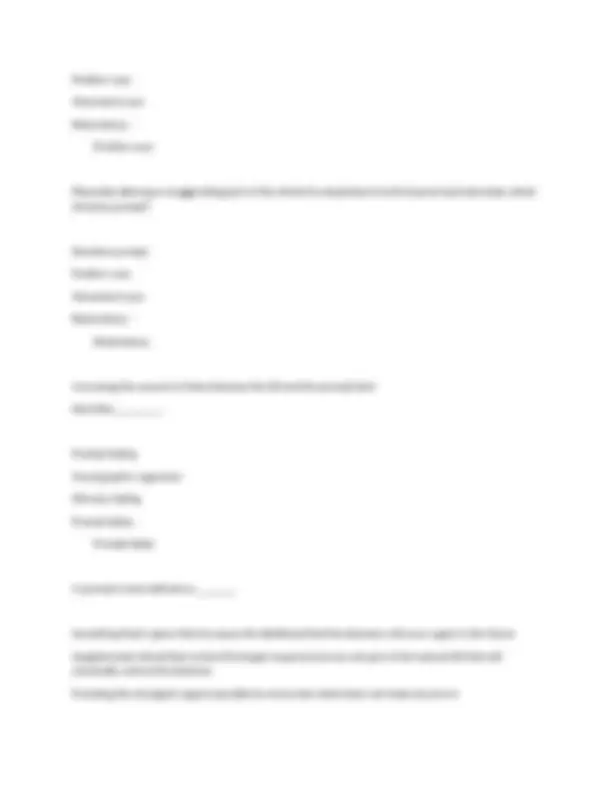
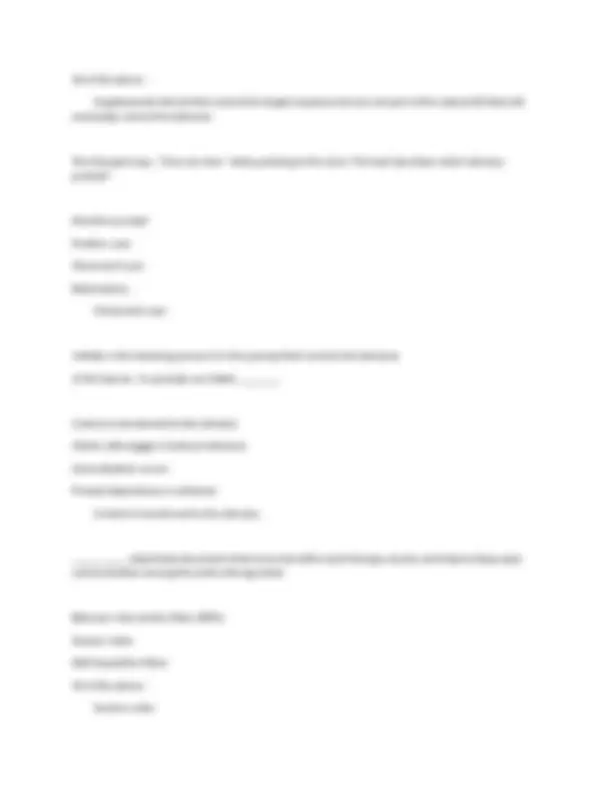
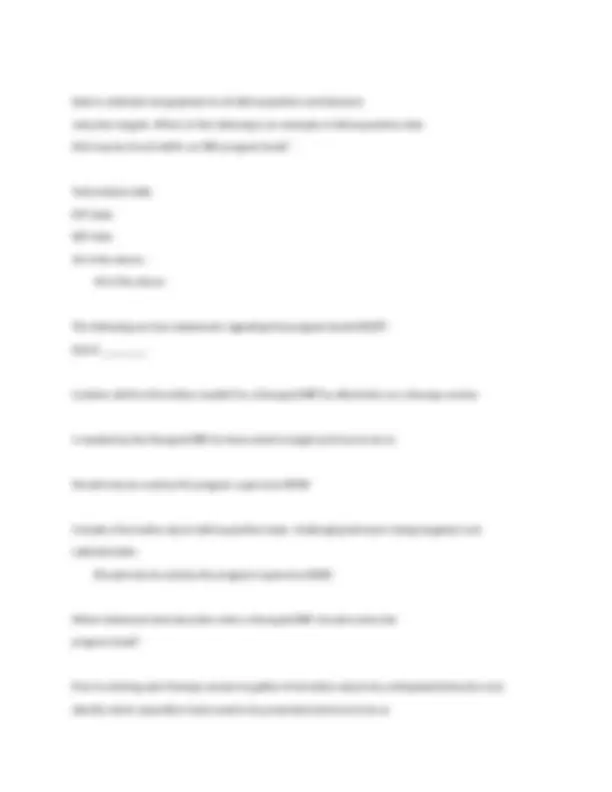
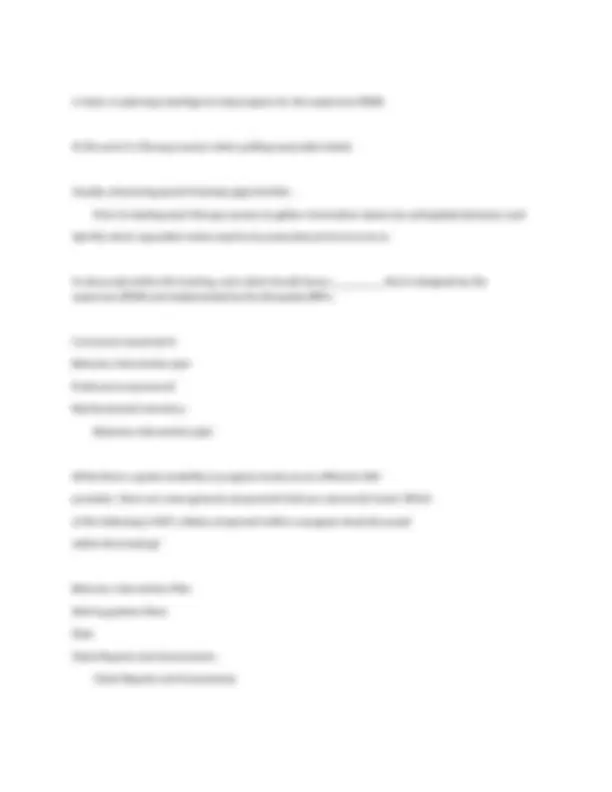
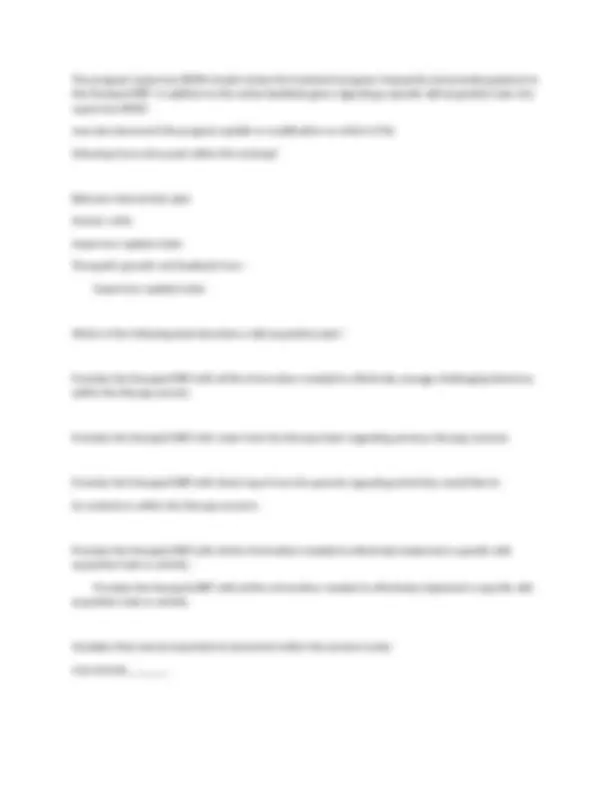
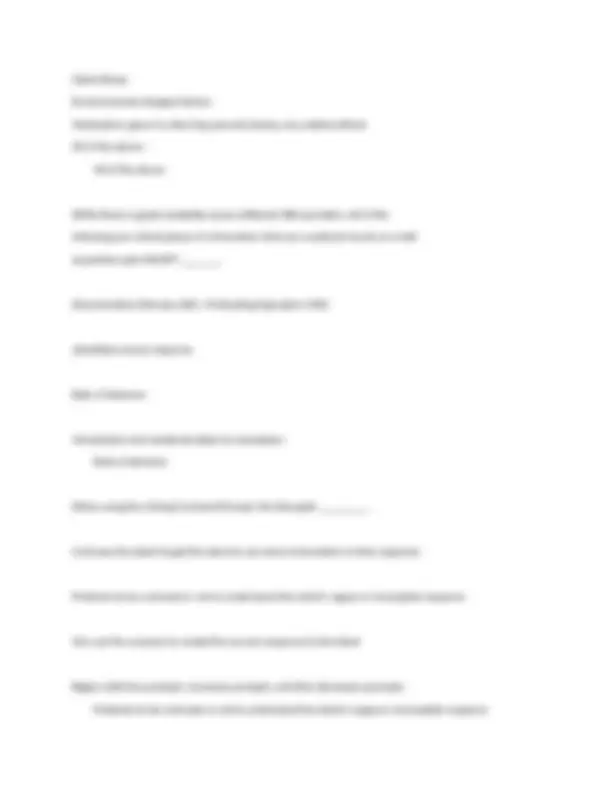
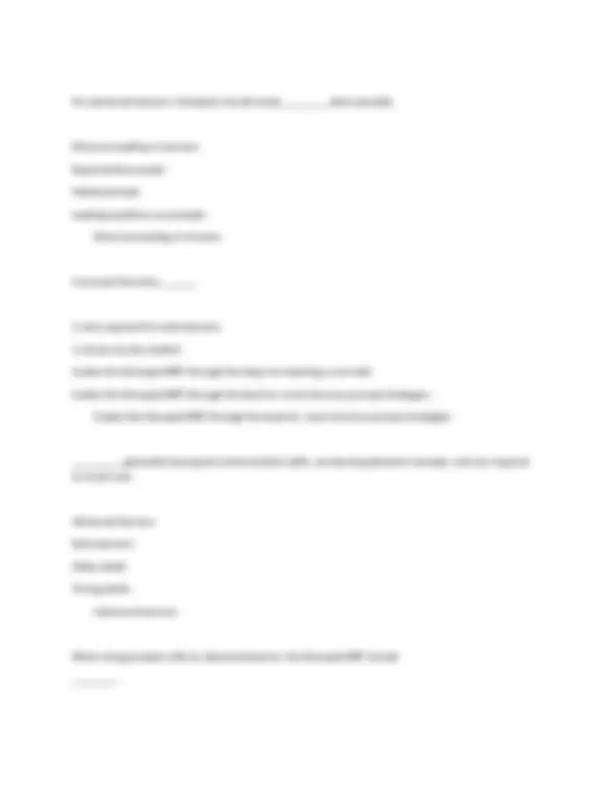
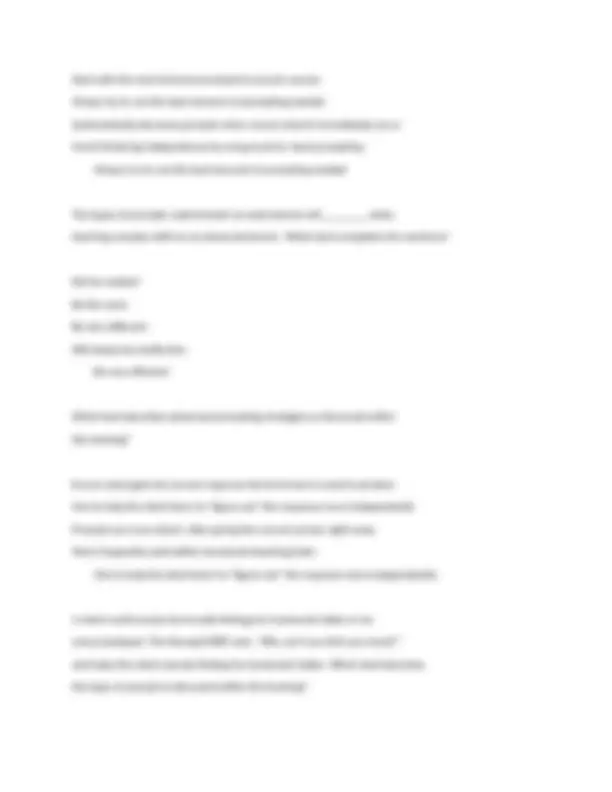
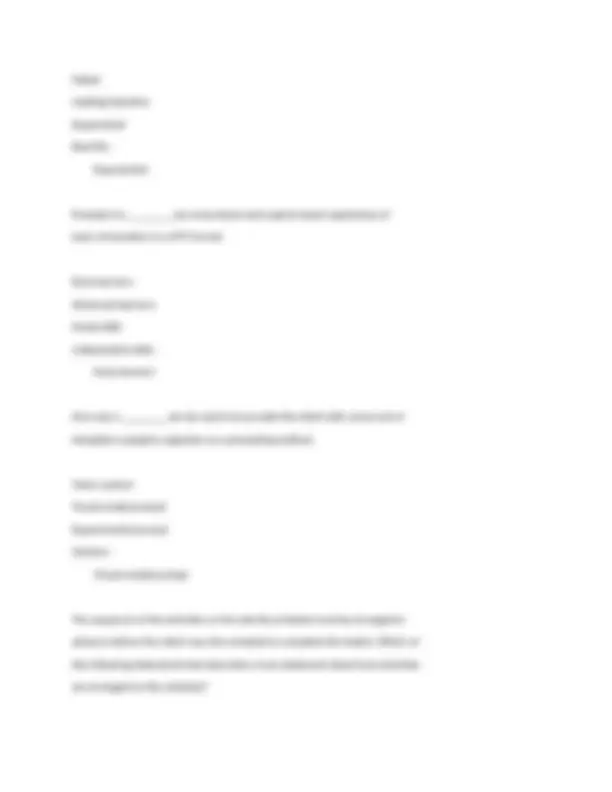
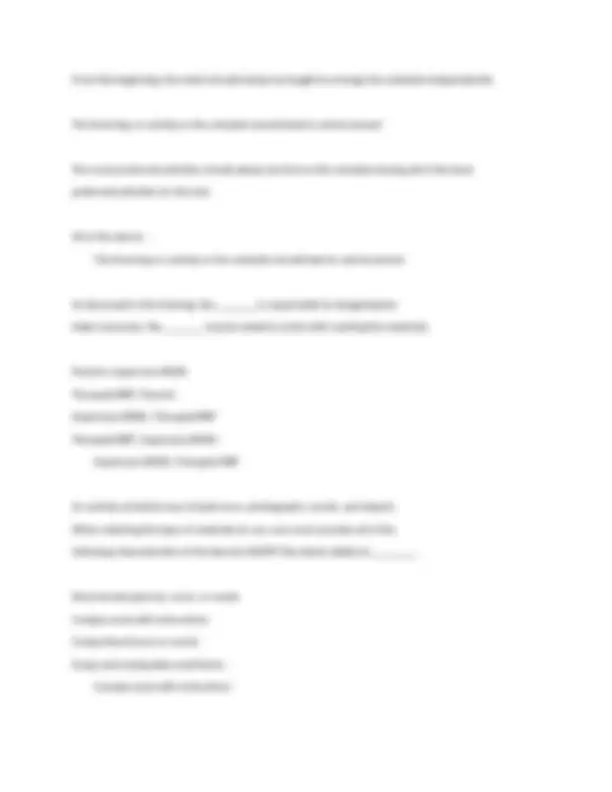
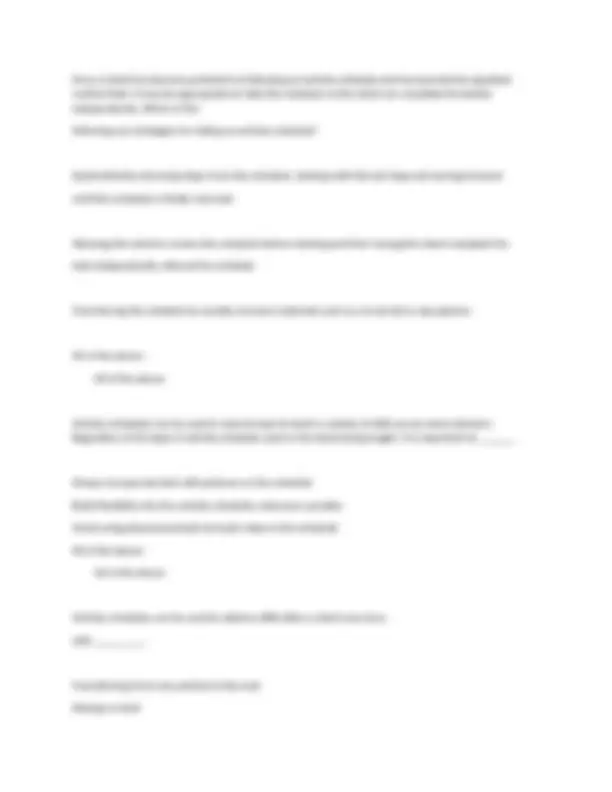
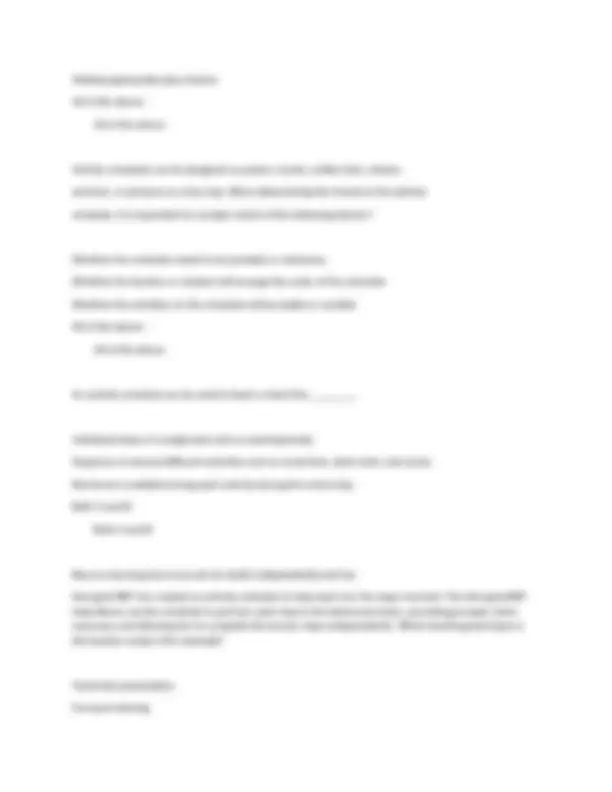
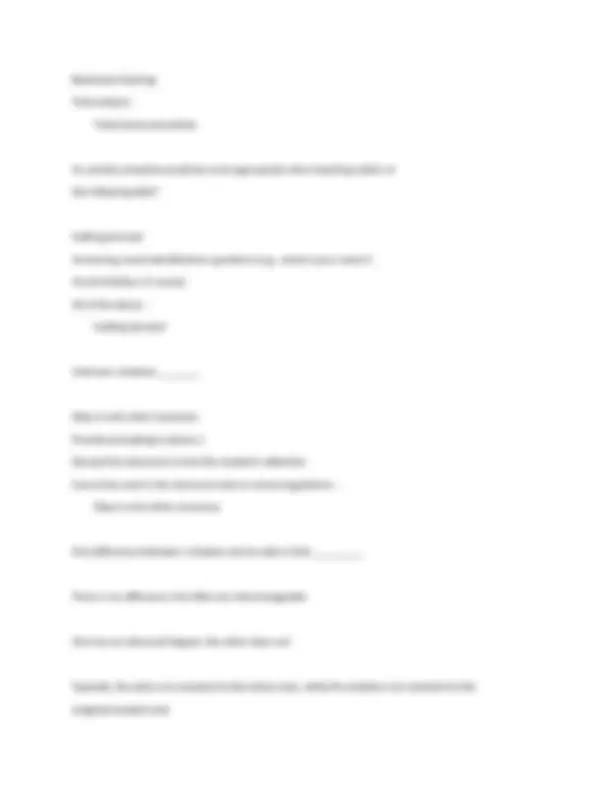
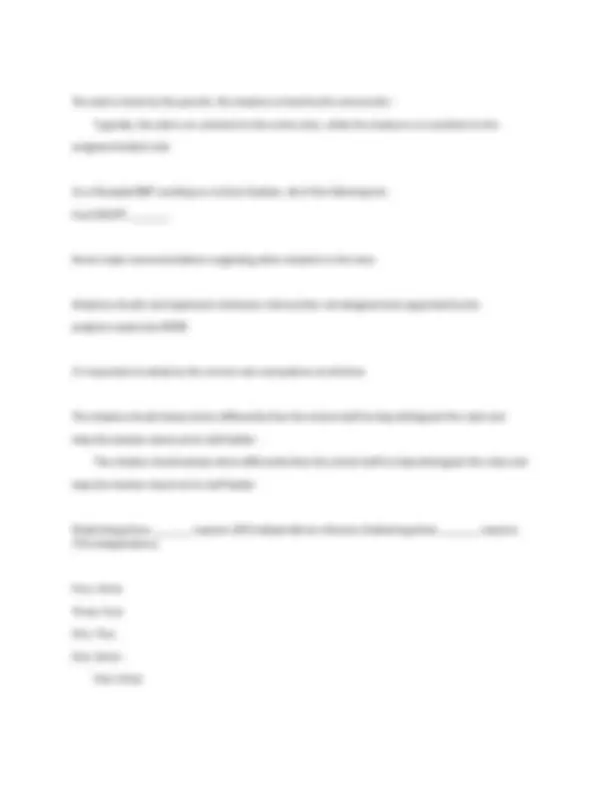
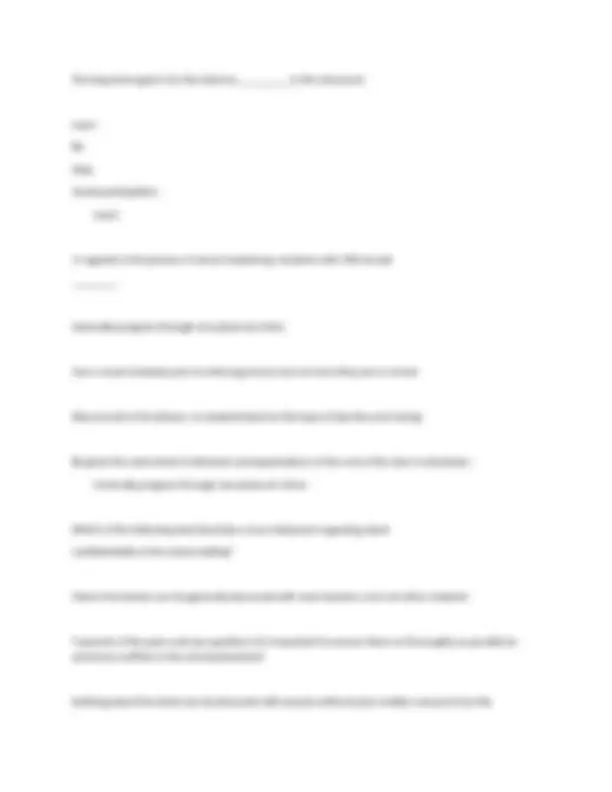

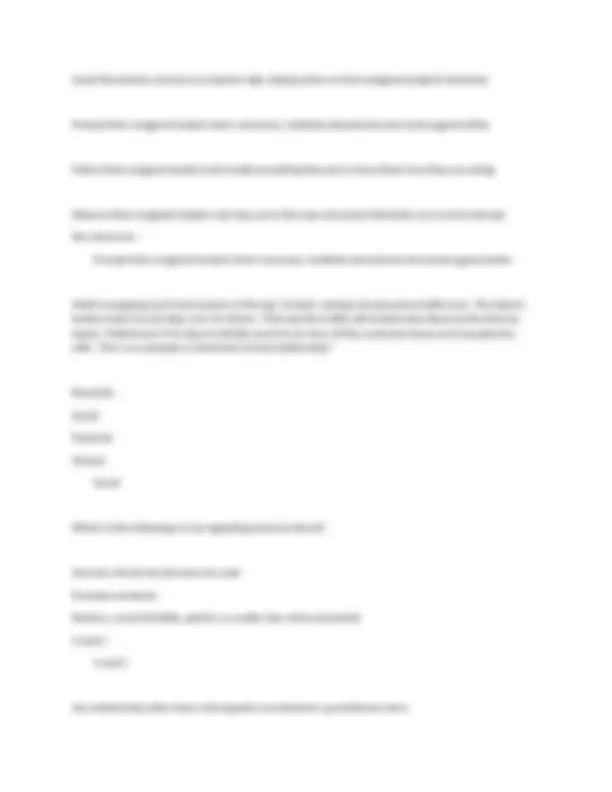
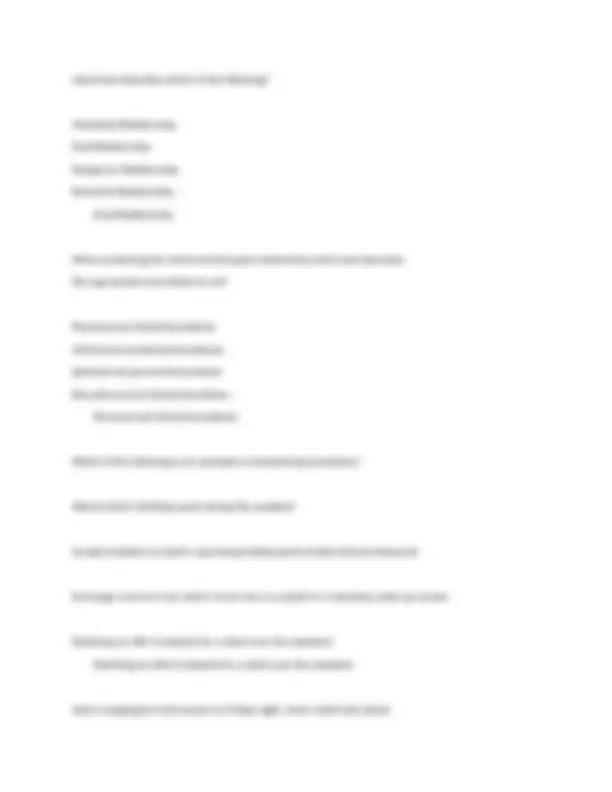
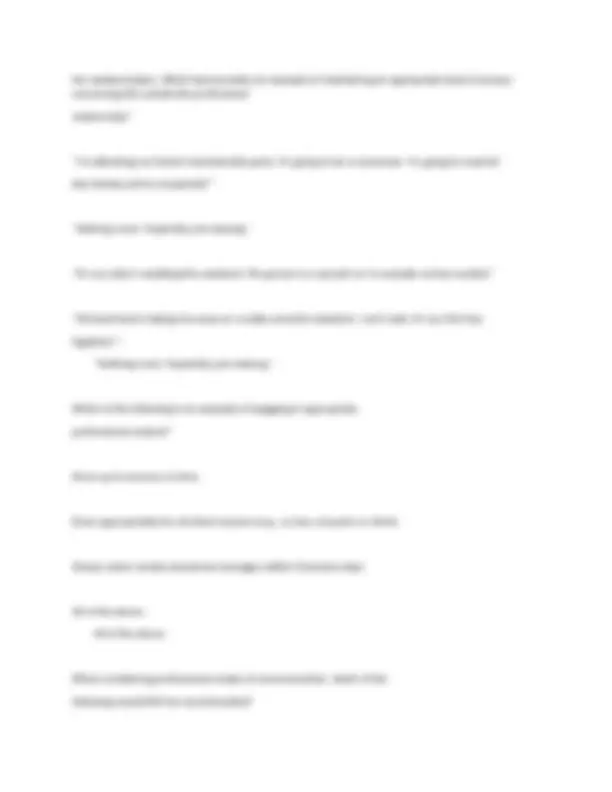
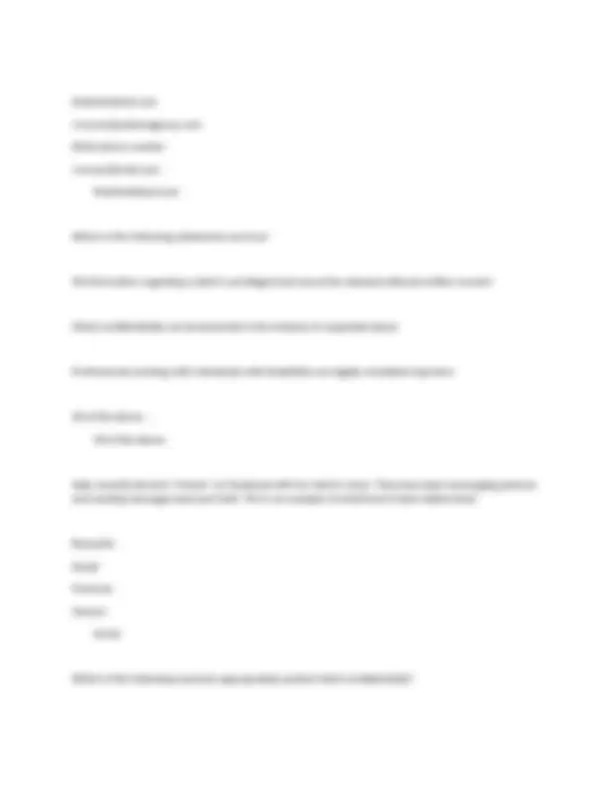
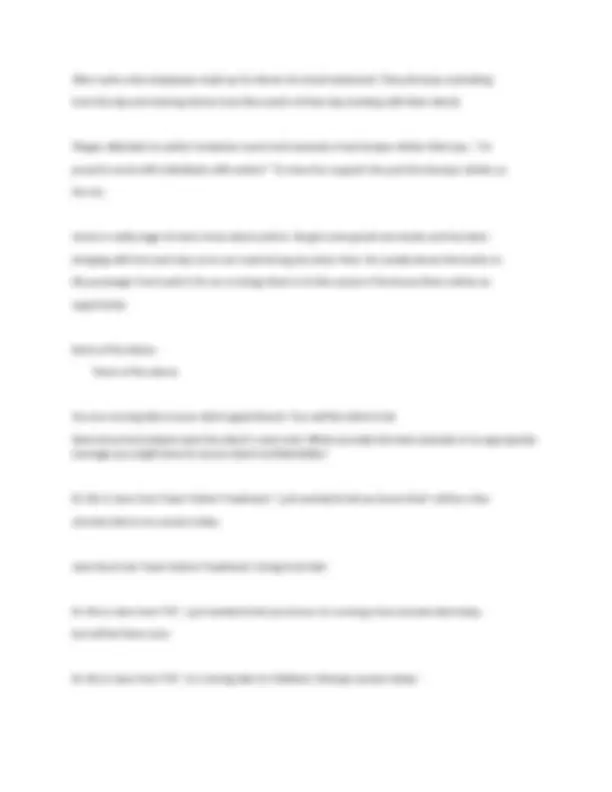
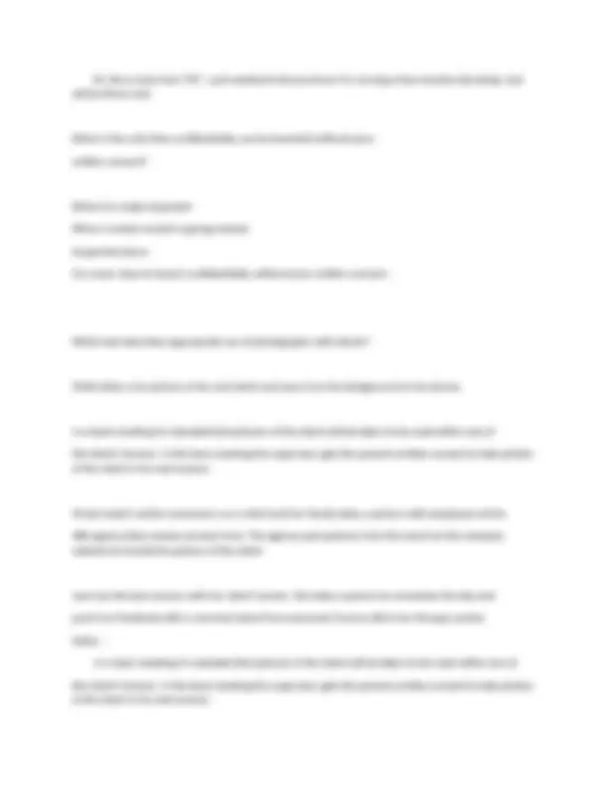
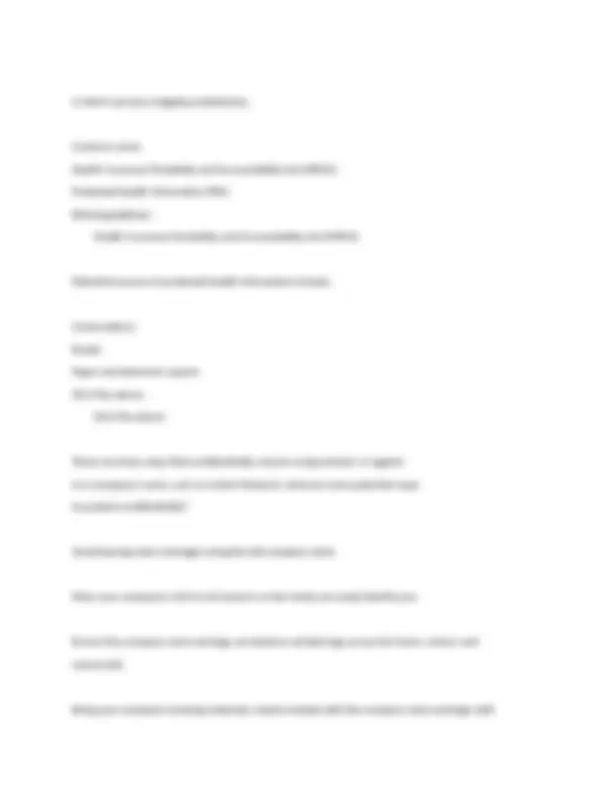
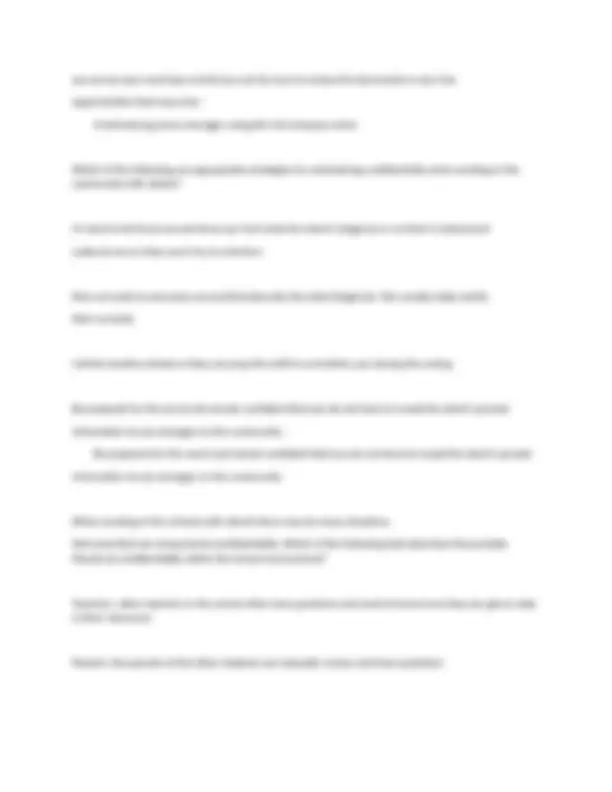
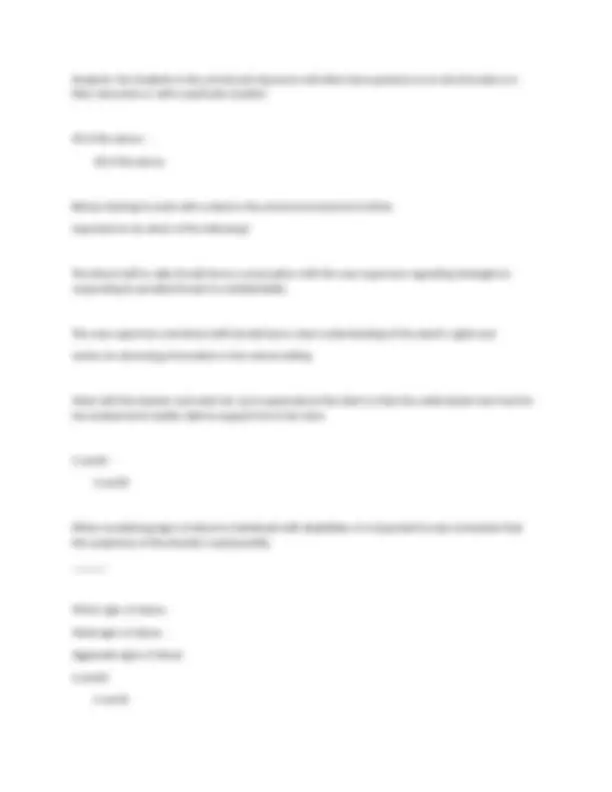
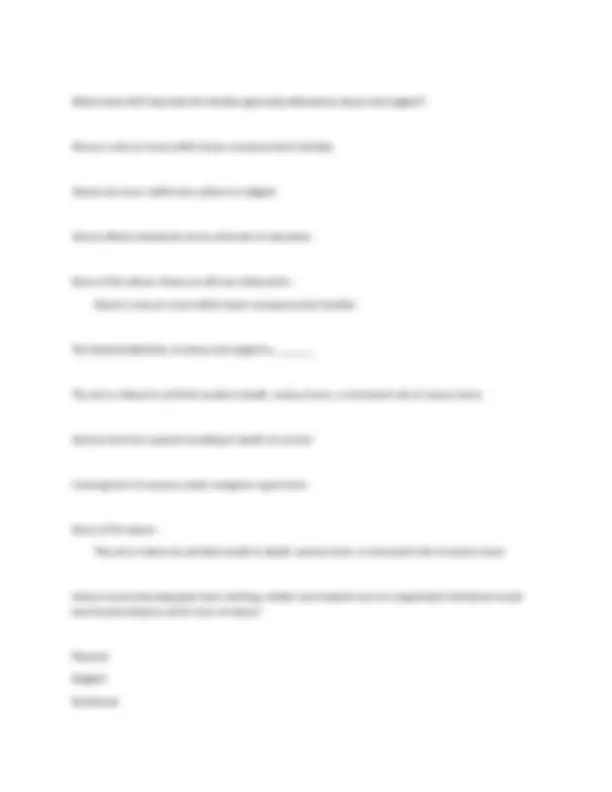
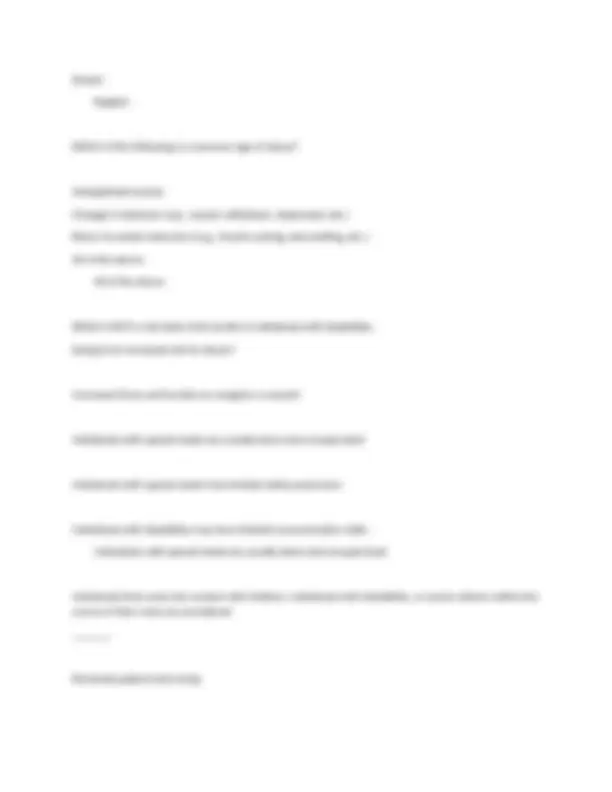
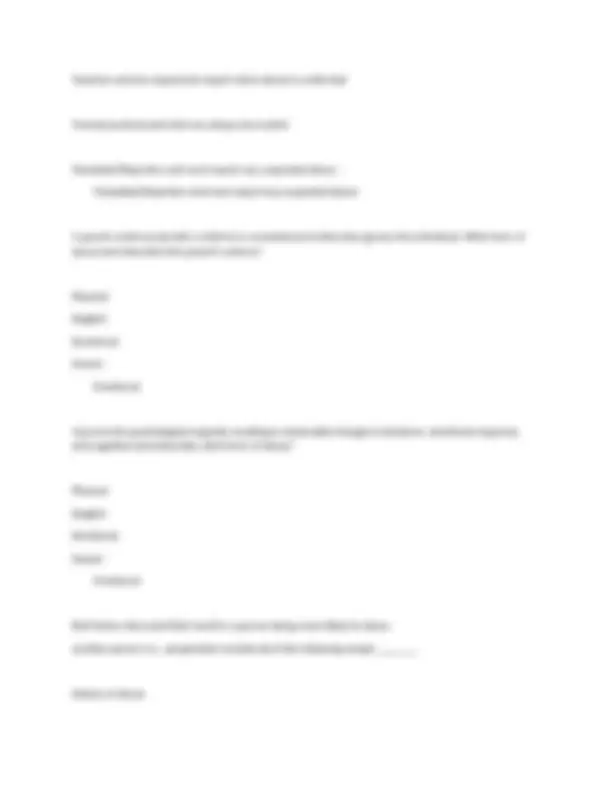
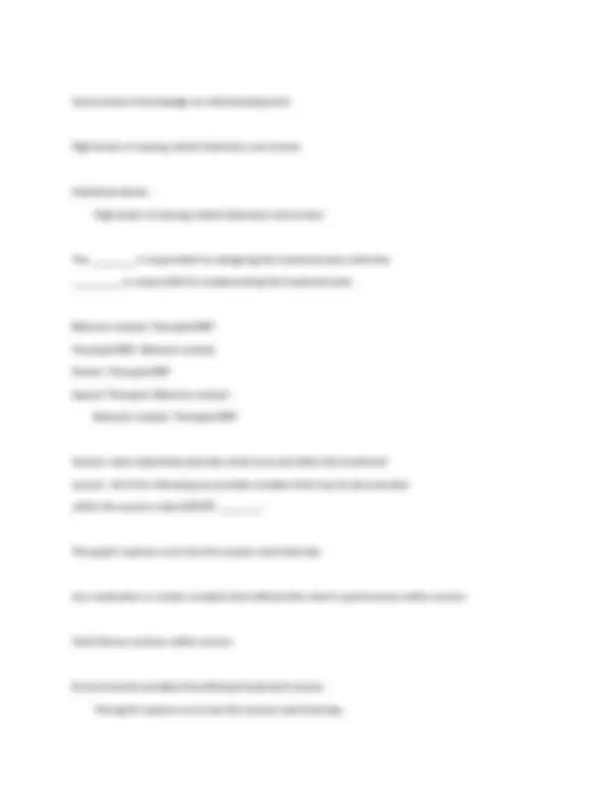
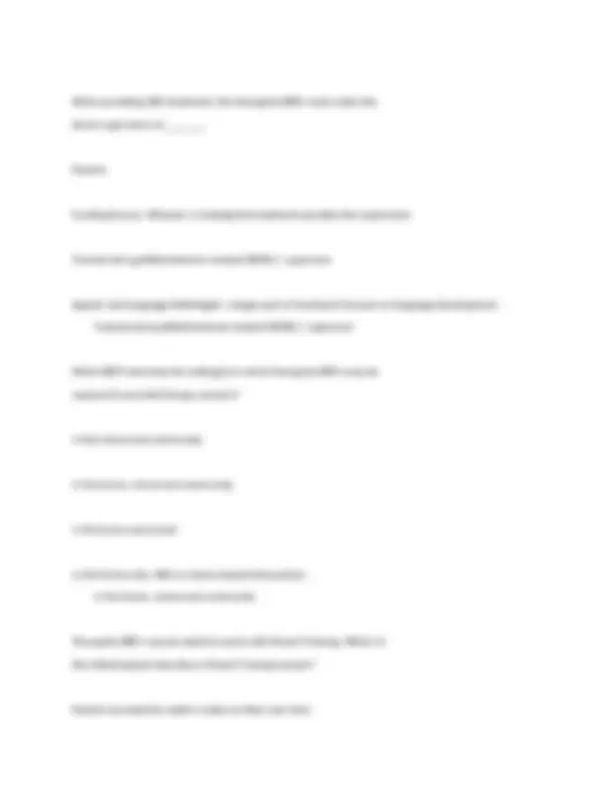
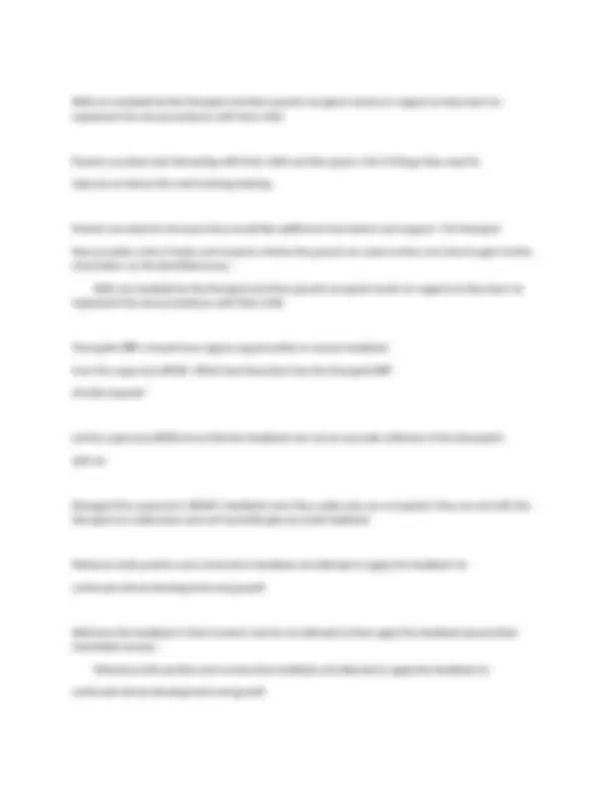
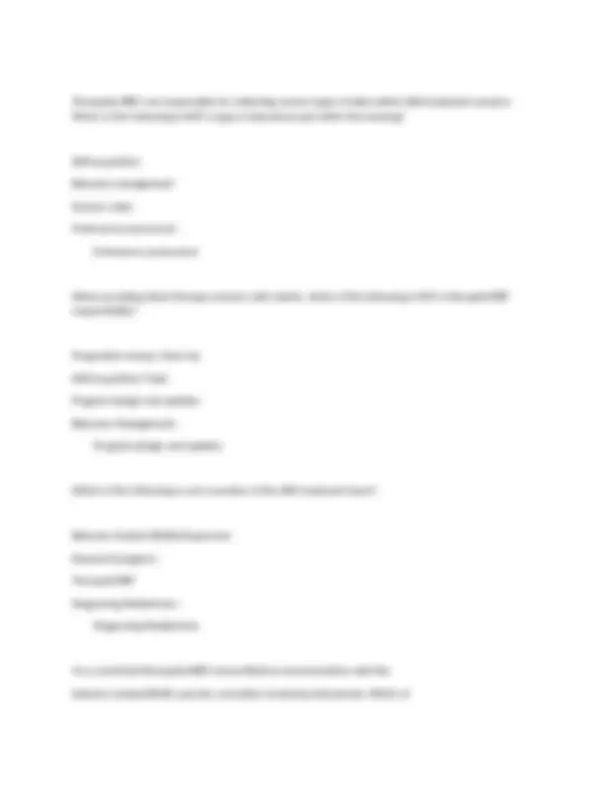
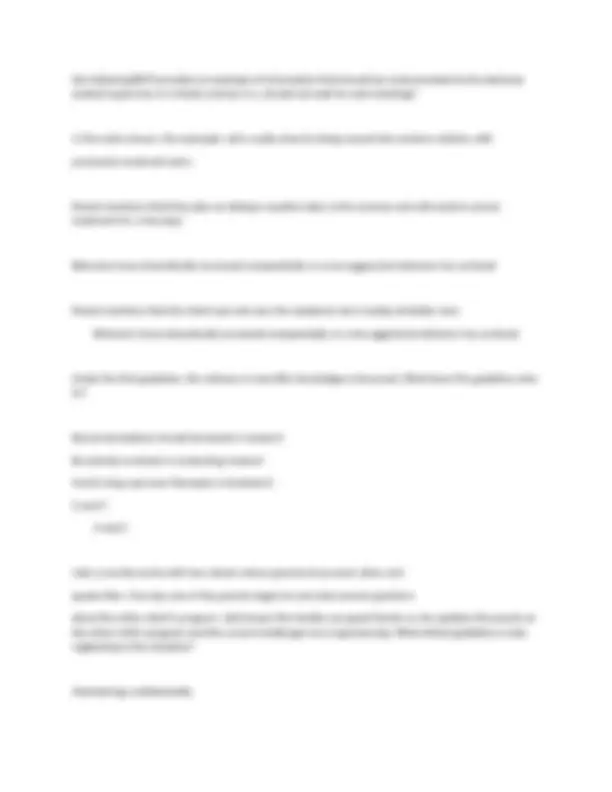
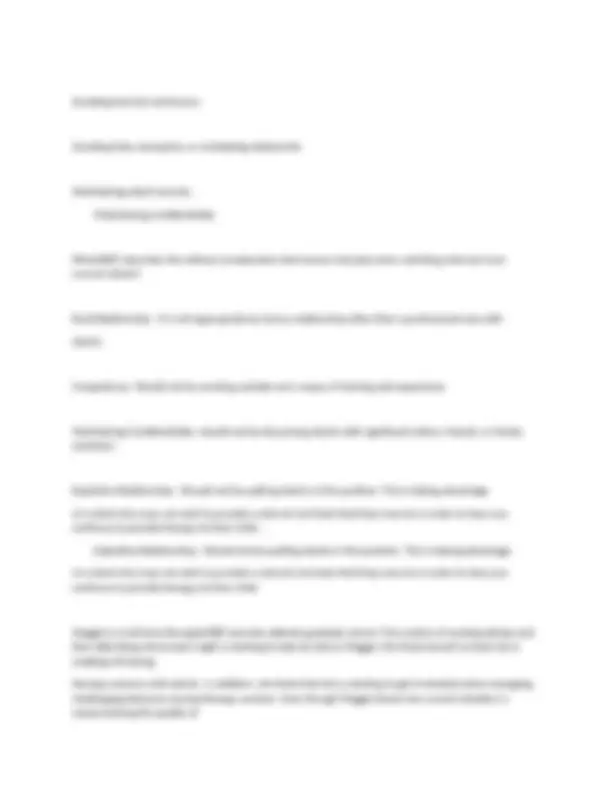
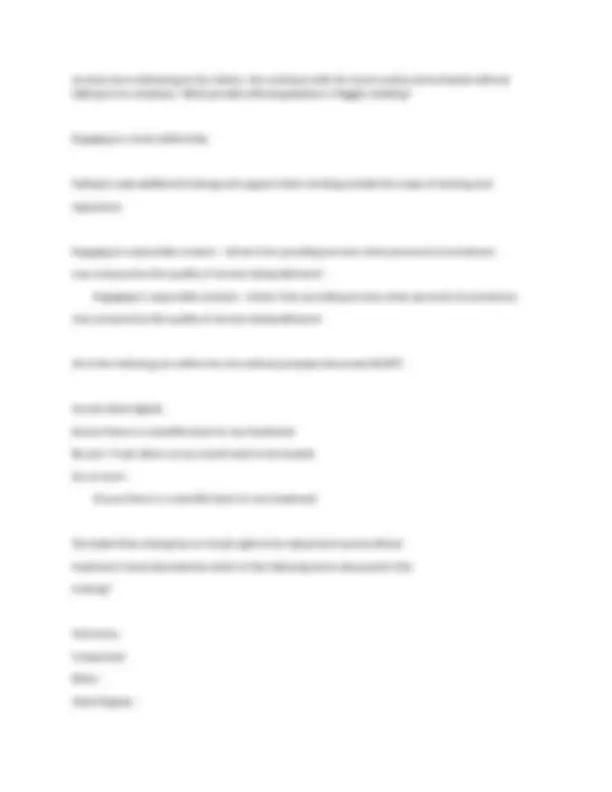
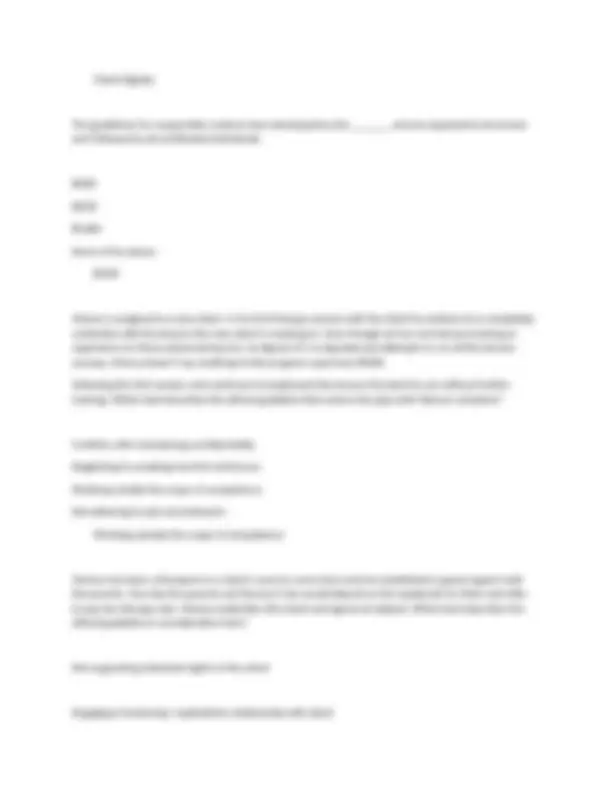
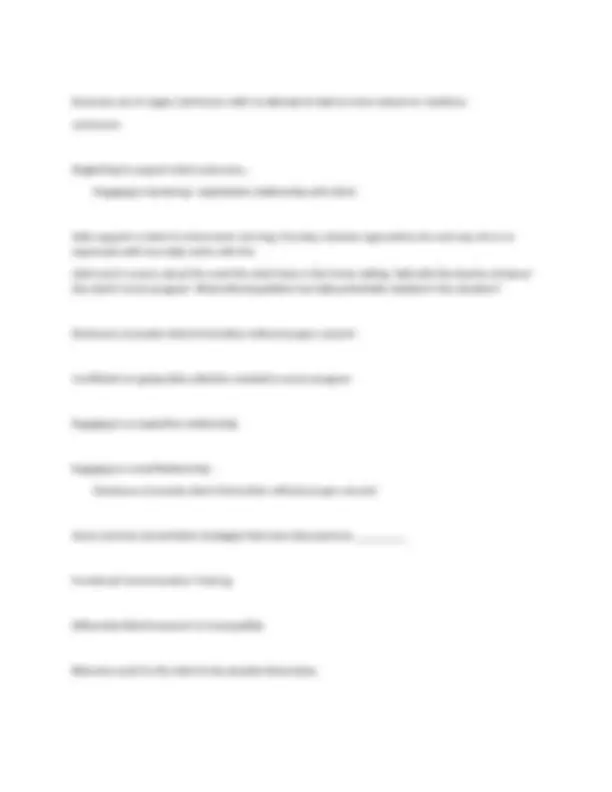
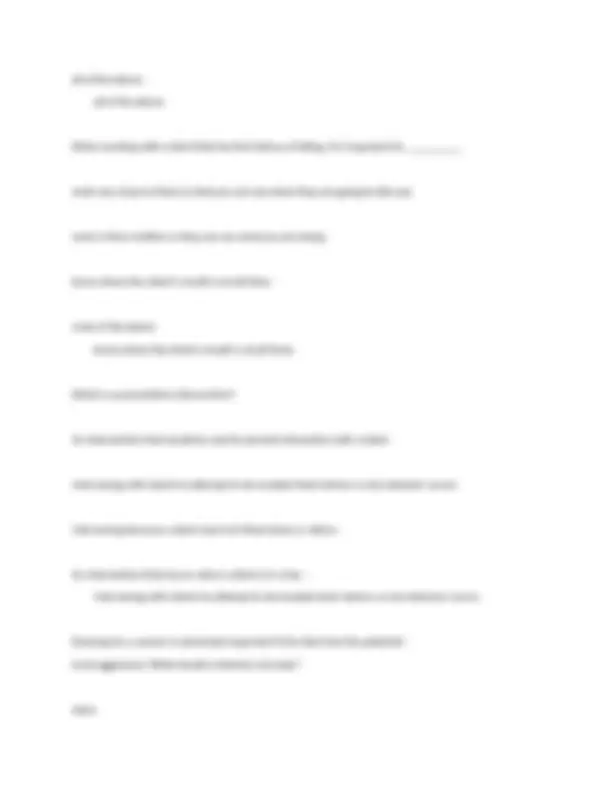
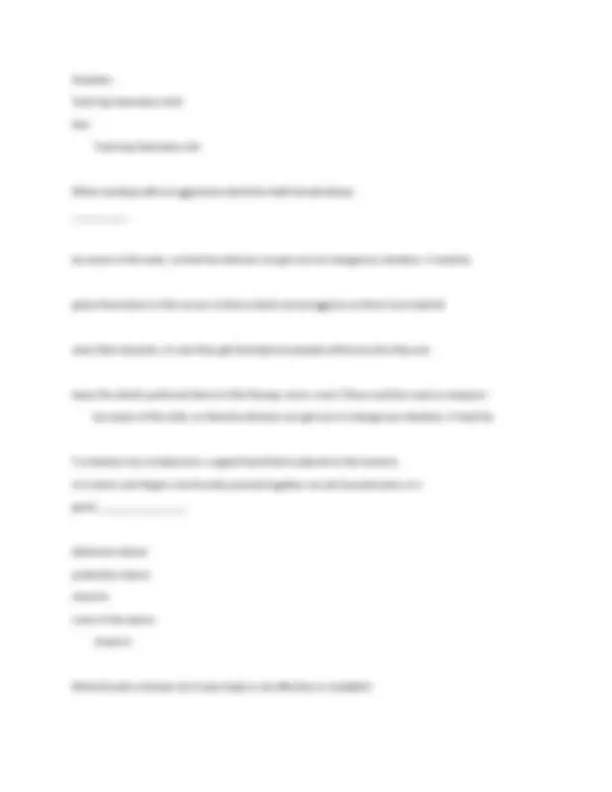
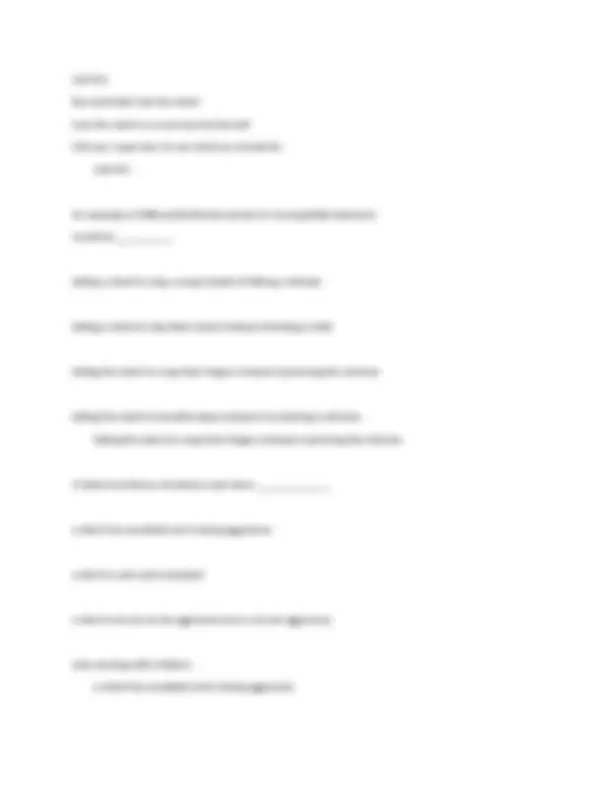
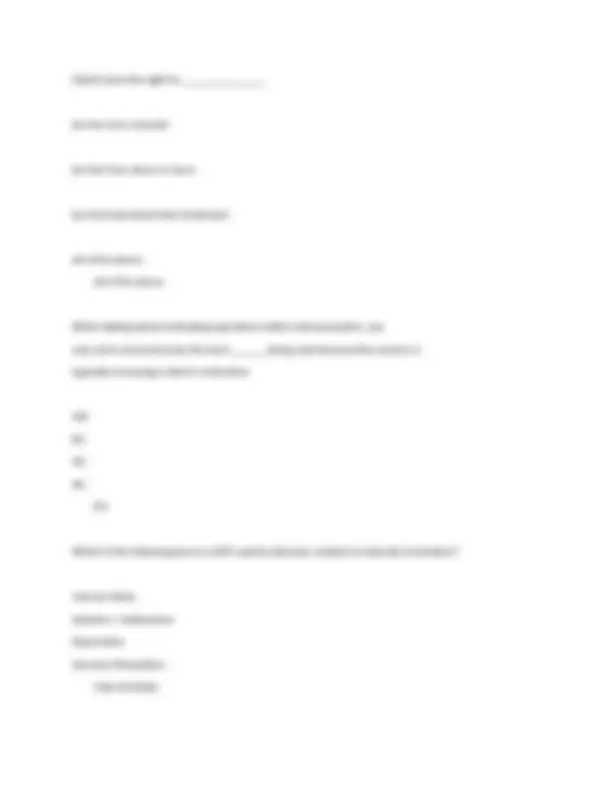
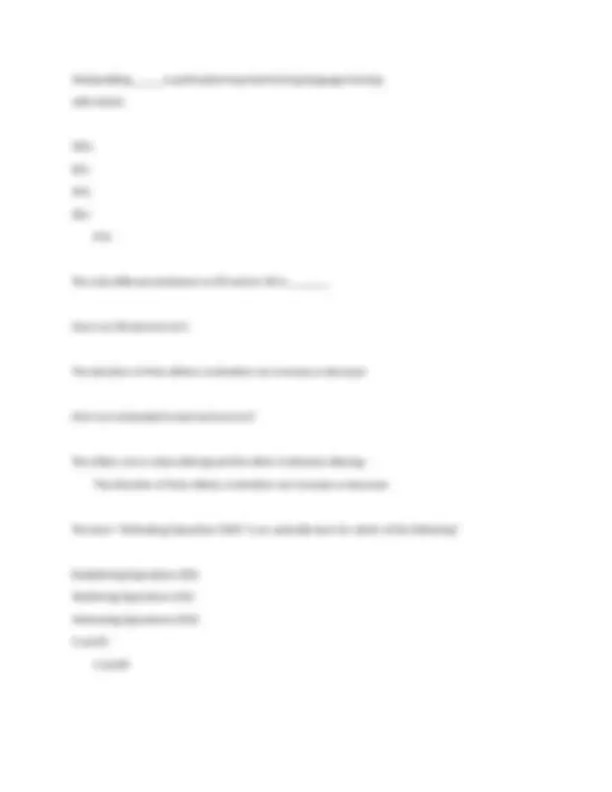
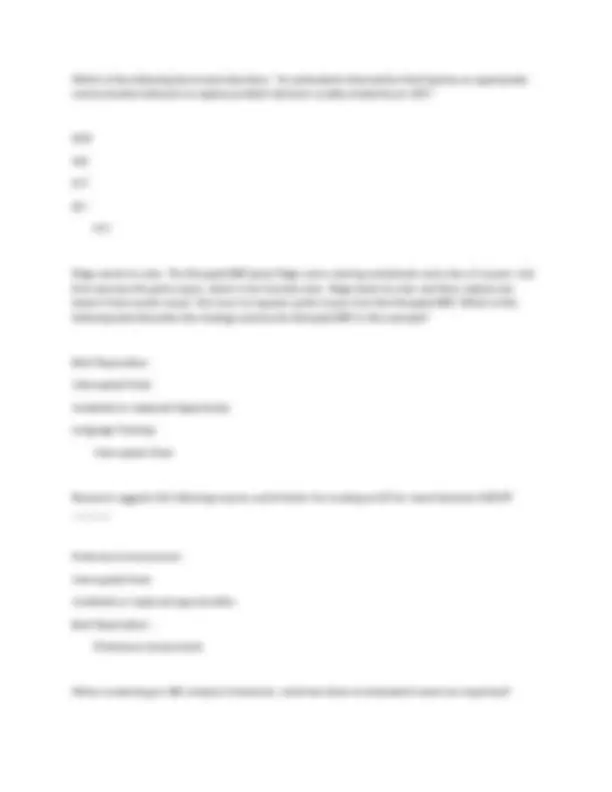
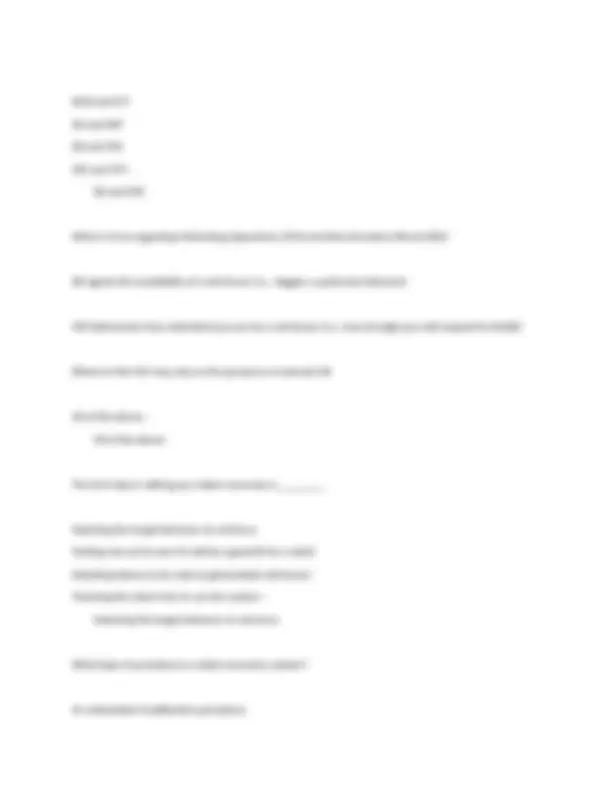
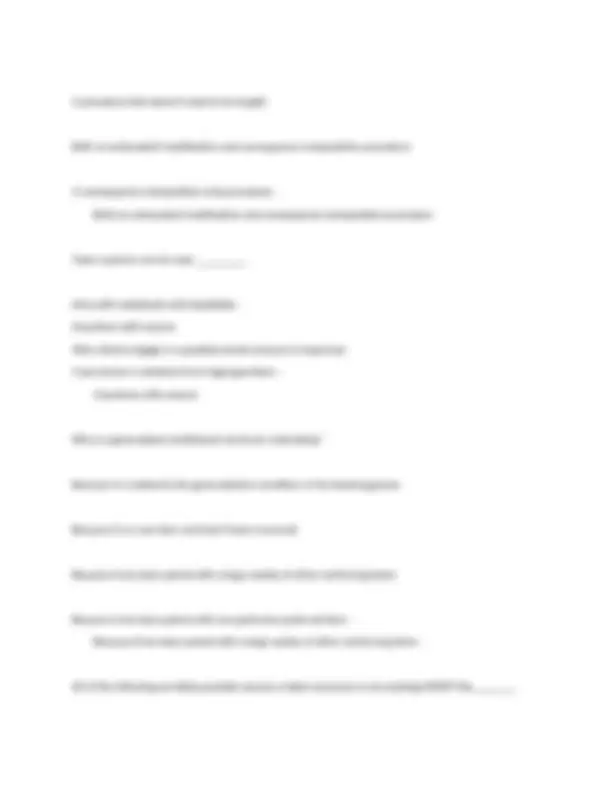
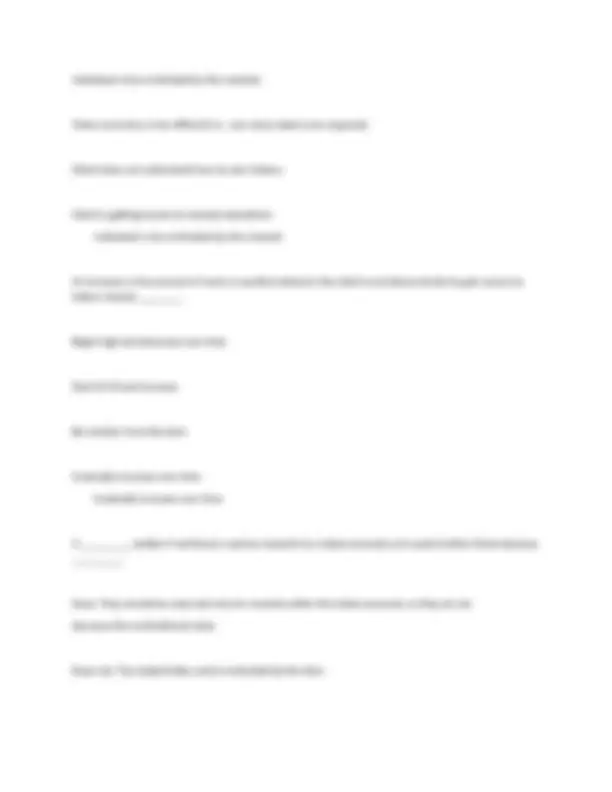
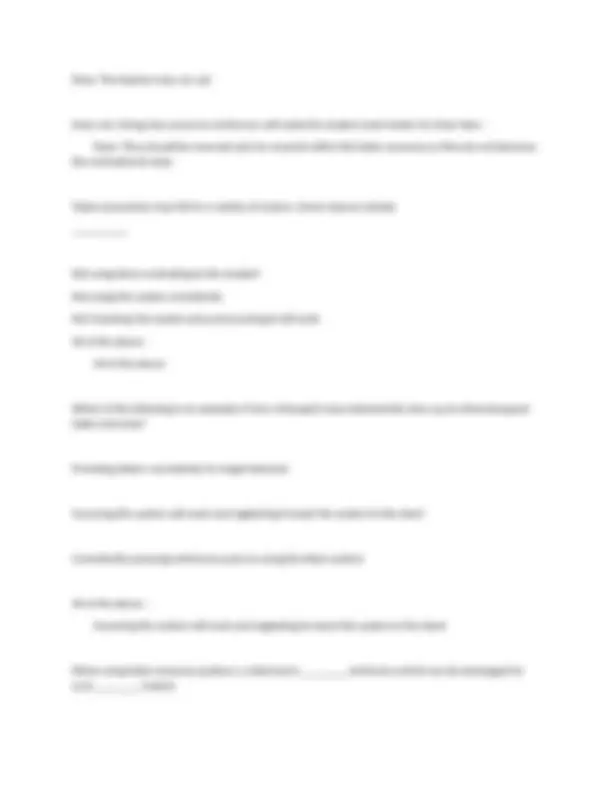



Study with the several resources on Docsity

Earn points by helping other students or get them with a premium plan


Prepare for your exams
Study with the several resources on Docsity

Earn points to download
Earn points by helping other students or get them with a premium plan
Community
Ask the community for help and clear up your study doubts
Discover the best universities in your country according to Docsity users
Free resources
Download our free guides on studying techniques, anxiety management strategies, and thesis advice from Docsity tutors
Registered Behavior Technician (RBT) Examination
Typology: Exams
1 / 98

This page cannot be seen from the preview
Don't miss anything!



























































































What is EIBI? -Early Intensive Behavioral Intervention, and is used to treat young children with autism -Experimental Intensive Behavioral Intervention, and is used to treat persons with autism -Early Individualized Behavior Implementation, and is used to treat a variety of disorders -Every Individual Behaves Independently, and is used to treat a variety of disorders including -Autism Spectrum Disorders, Down Syndrome, and Fetal Alcohol Spectrum Disorders - Early Intensive Behavioral Intervention, and is used to treat young children with autism A therapist is working with a child that dislikes the task she is working on. The child pinches the therapist. The therapist responds by telling the child to take a break from the work and think about what she did. In the future, the child pinches any time she doesn't want to do her work. In this example, the consequence for pinching was ________. -Receiving a break from work which functioned as a punisher -Receiving a break from work which functioned as a reinforcer -Receiving more work which functioned as a reinforcer -Receiving a vocal reprimand that functioned as a punisher - Receiving a break from work which functioned as a reinforcer What is the 3-term contingency (hint: ABC)? -Application, Behavior, Circumstances -Antecedent, Behavior, Contingencies -Antecedent, Behavior, Consequence
-Alternative Behavior Choices - Antecedent, Behavior, Consequence What is the core principle of ABA? -Behavior is a function of its consequences -Behavior is controlled by a person's mental state -Always use reinforcement -People are products of their environments - Behavior is a function of its consequences Autism is a developmental disorder that appears by the age of 3 and is characterized by: -Repetitive behavior patterns and impairment in social interactions and communication -Repetitive behavior patterns, stereotypy, and deficits in eye contact -Below average IQ and deficiency in motor skills -Obsessive thoughts, repetitive behavior patterns, and impairment in social skills - Repetitive behavior patterns and impairment in social interactions and communication What is the definition of ABA? -Application of the principles of behavior to issues that are socially important to produce practical change -The use of behavioral principles to treat autism spectrum disorders -Discrete Trial Training -Application of the principles of behavior to decrease inappropriate behaviors - Application of the principles of behavior to issues that are socially important to produce practical change
mom responds, "Yes, it's a clown!" This is an example of _______. -Verbal behavior -Vocal behavior -A &B -None of the above - Vocal & Verbal Behavior Which of the following is a potential benefit of developing a manding repertoire? -Decrease in inappropriate or problem behaviors -Facilitation of the acquisition of other verbal operants -Language is acquired faster by children when they are being taught to mand -All of the above - -Decrease in inappropriate or problem behaviors -Facilitation of the acquisition of other verbal operants -Language is acquired faster by children when they are being taught to mand Which of the following is a key feature of NET? -It is adult directed and uses repetition and sequenced instruction -The child is provided with several brief, timed opportunities to practice the skill target -Targets are often taught in a particular sequence; building speed and accuracy in basic skills before focusing on more complex skills -It is largely child-directed and performed in natural settings - It is largely child-directed and performed in natural settings Which of the following is a behavioral teaching approach?
-Discrete Trial Training (DTT) -Natural Environment Training (NET) -Fluency Based Instruction -All of the above - All of the above Which of the following operants is often referred to as labeling? -Echoic -Mand -Tact -Intraverbal - Tact Effective EIBI language programs focus on which of the following? -Verbal Behavior topography -Expressive language development -Verbal Behavior function -Mand training - Verbal Behavior function Which of the following best describes Verbal Behavior? -Any behavior for which the consequence is mediated by the behavior of another person -When one speaks or produces a sound -Responding vocally to another person's nonvocal behavior -Vocal behavior for which the consequence is mediated by the vocal behavior of another person - Any behavior for which the consequence is mediated by the behavior of another person
-A consequence that increases a behavior -A consequence that maintains or increases a response under similar circumstances -A reward provided that lets the child know they are correct - A consequence that maintains or increases a response under similar circumstances Which of the following is NOT a reason why we use Discrete Trail Training when teaching children with Autism Spectrum Disorder? -Children with autism often have more difficulty learning through observation of peers -It maximizes the number of teaching opportunities -It provides an extremely structured learning environment -It is less frustrating because it is child guided - It is less frustrating because it is child guided A motivating operation that increases the effectiveness of a stimulus to function as a reinforcer is known as a(n): -Prompt -Conditioned Stimulus (CS) -Discriminative Stimulus (SD) -Establishing Operation (EO) - Establishing Operation (EO) A therapist is trying to teach a child to follow the instruction, "sit down". After the child complies and sits down, the therapist says, "Yay!!!" which increases the likelihood that the child will sit down in the future when given the instruction, "sit down". What is the praise functioning as? -A secondary reinforcer
-A primary reinforcer -A punisher -None of the above - A secondary reinforcer What are the three parts of the discrete trial? -The instruction, the stimuli, and feedback -The instruction, the response, and the next instruction -The setting, the stimuli, and the behavior -The antecedent (Sd and/or EO), the response, and the consequence - The antecedent (Sd and/or EO), the response, and the consequence What are the three categories of responses? -Correct, partially correct, incorrect -Incorrect, correct, no response -Prompted, correct, no response -The premise of the question is false; there are only two: correct and incorrect - Incorrect, correct, no response A stimulus that indicates the availability of reinforcement for a given behavior is known as a(n): Prompt Conditioned Stimulus (CS) Discriminative Stimulus (SD) Establishing Operation (EO) - Discriminative Stimulus (SD)
The systematic removal of additional stimuli so that the child is responding independently to the SD A consequence that leads to an increase in the behavior Reinforcing successive approximations towards a desired response while extinguishing previous approximations Providing additional stimuli to ensure a correct response - Reinforcing successive approximations towards a desired response while extinguishing previous approximations What is mass trial? Repeated presentation of the same SD & target A procedure for teaching multiple targets simultaneously A form of child guided therapy where the therapist follows the child and works on targets as they come up naturally When 10 or more people are all being tried in a courtroom at the same time - Repeated presentation of the same SD & target The colors lesson has not been introduced yet. The supervisor wants you to introduce the first targets by placing out color cards on the table and giving the instruction "Give me (color)". Which teaching procedure should you use? Natural Environment Training Simultaneous discrimination training Successive discrimination training Randomized Intertrial Training (RIT) - Simultaneous discrimination training Errorless learning is a teaching procedure that _______.
ensures a child never responds incorrectly involves a least-to- most prompting procedure involves the therapist never informing the child of any incorrect responses involves a most-to- least prompting procedure to minimize incorrect responding - involves a most-to- least prompting procedure to minimize incorrect responding Which of the following is an example of most-to- least prompt fading? Vocal, Physical, Textual Physical, Model, Partial Physical Physical, Partial Physical, Vocal Model, Vocal, Physical - Physical, Partial Physical, Vocal What is the process of breaking down a behavior chain into a sequence of individual SD-response components called? Shaping Prompting Task Analysis Discrimination Training - Task Analysis If a child has all ready learned the emotions, "happy", "sad", and "angry", and the next target is "scared", how would you teach "scared" if the SD is "show me (emotion)? Mass trial "scared" first and then Random Rotate with the previously mastered targets
The systematic removal of additional stimuli so that the child is responding independently to the SD - A sequence of SDs and responses where each response in the sequence (except the last) produces the next SD Which of the following is a type of prompt? Physical Model Vocal All of the above - All of the above Which is an example of a procedure for establishing a chain? Total task presentation Forward chaining Backward chaining All of the above - All of the above Which of the following is an example of shaping? If you are trying to teach a child to say bubbles, you first reinforce "Bu" and after the child becomes fluent with "Bu", you move to "Bub", and proceed adding more and more of the word contingent on the child's success until the child is saying "bubbles". If a child tantrums every time he wants candy and the parents begin to give in less and less frequently until the child does not tantrum any more. If a child is inflexible with getting his clothes wet, you get his shirt soaking wet and not allow
him to change it until he calms down at which point you reinforce his tolerating of a soaking wet shirt. If you are trying to teach a child to ride a bike and you do not provide reinforcement for small successes, only once he is riding successfully. - If you are trying to teach a child to say bubbles, you first reinforce "Bu" and after the child becomes fluent with "Bu", you move to "Bub", and proceed adding more and more of the word contingent on the child's success until the child is saying "bubbles". What is discrimination training? A procedure used solely with rats and pigeons in research The procedure for teaching the child to distinguish between two or more SDs An error correction procedure Reinforcing successive approximations towards a desired response - The procedure for teaching the child to distinguish between two or more SDs The presentation of two or more SDs in random order is known as: Mass trial Random rotation Random sampling Errorless learning - Random rotation Fading is: Providing an additional stimulus to facilitate a correct response Systematically removing prompts contingent on correct responding Providing corrective feedback contingent on incorrect responding A procedure not used in Applied Behavior Analysis -
provides attention when the problem behavior occurs. Which type of extinction intervention is the therapist using? Response Blocking Escape Extinction Planned Ignoring Non-Exclusionary Time Out - Planned Ignoring Austin begins to repeatedly scream when his mom tells him he cannot go outside to play. After five minutes, Austin's mom agrees to let him outside into the garden. The next time Austin wants to play outside he immediately begins to scream. His mom immediately lets him go outside to play. Austin's mom's behavior has been: Positively reinforced Negatively reinforced Negatively punished Positively punished - Negatively reinforced Anything a person says or does is known as: Antecedents Discriminative Stimulus Consequences Behavior - Behavior Carl suffers from eczema, a skin rash that is extremely itchy. His teacher
complains that he is always scratching his arms and often makes them bleed from scratching too much. No matter what the teacher does, Carl continues to scratch himself. Carl's scratching is likely to be maintained by _______. Social positive reinforcement Social negative reinforcement Automatic positive reinforcement Automatic negative reinforcement - Automatic negative reinforcement ABC recording is an example of: Descriptive assessment Parent Interview Experimental Functional Analysis Indirect Assessment - Descriptive assessment A functional analysis revealed that Jenny's aggressive behavior is maintained by escaping from a demand. In order to decrease Jenny's aggression, her therapists provide her with frequent breaks throughout the therapy session. What type of antecedent based intervention is being used? Non-contingent Reinforcement (NCR) Task modification Differential reinforcement of alternative behaviors (DRA) Demand Fading - Non-contingent Reinforcement (NCR)
Functional assessment Direct observation Experimental functional analysis Experimental observation - Experimental functional analysis Which of the following is not a characteristic of Extinction? Gradual Decrease in behavior Spontaneous Recovery Extinction Burst Behavior substitution - Behavior substitution Consequence based interventions are designed to: Eliminate the reinforcer maintaining the problem behavior Teach the child to accept new reinforcers Teach the child alternative ways of gaining access to reinforcers Eliminate the the SDs or EOs that are evoking the problem behavior - Eliminate the reinforcer maintaining the problem behavior Replacement behavior based interventions involve: Teaching the child to regulate their own responses Teaching the child that problem behavior will result in negative consequences Delivering reinforcement contingent on very low rates of problem behavior Teaching the child an appropriate substitute for problem behavior -
Teaching the child an appropriate substitute for problem behavior Holly's program supervisor has specified that all of a her mands, vocal and non-vocal, are to be recorded throughout her entire therapy session. Which type of recording method will her therapists use? Discrete Trial Recording Continuous Recording Trial by trial recording Interval recording - Continuous Recording Probes differ from instructional procedures in that: Reinforcement is provided for correct responses, but error correction procedures are not used No consequence is provided Positive consequences are provided for all responses None of the above - No consequence is provided Pre-instructional probes are conducted: Before teaching a new skill in order to determine what skills a child knows and which skills need to be taught After teaching a new skill in order to determine if a recently taught skill is indeed known, or whether it needs additional practice Throughout teaching a new skill, in order to determine when the skill is mastered Whenever a child is not showing progress, in order to determine what step to take next - Before teaching a new skill in order to determine what skills a child knows and which skills need